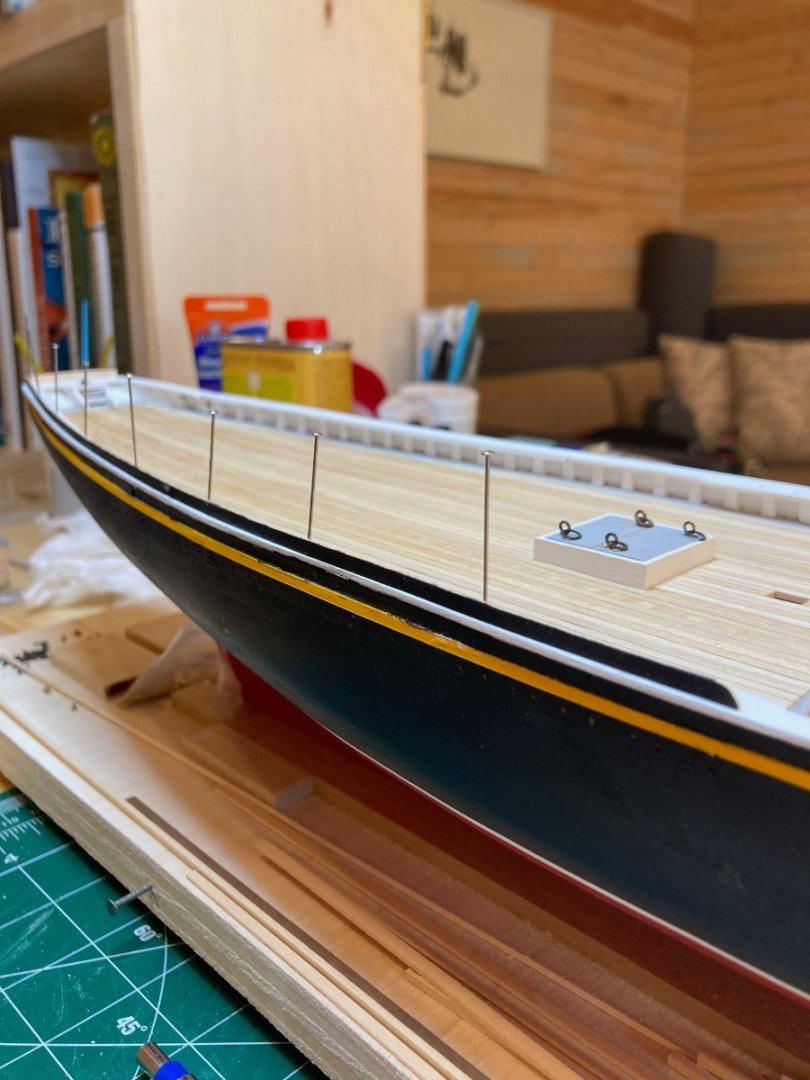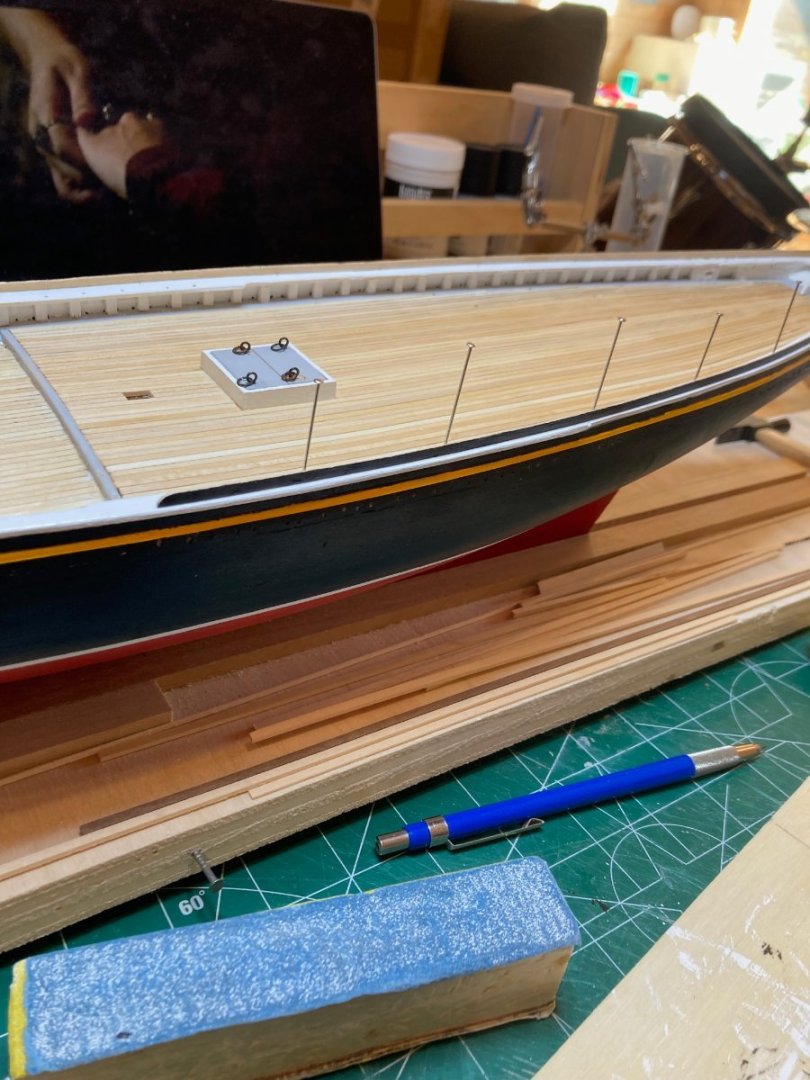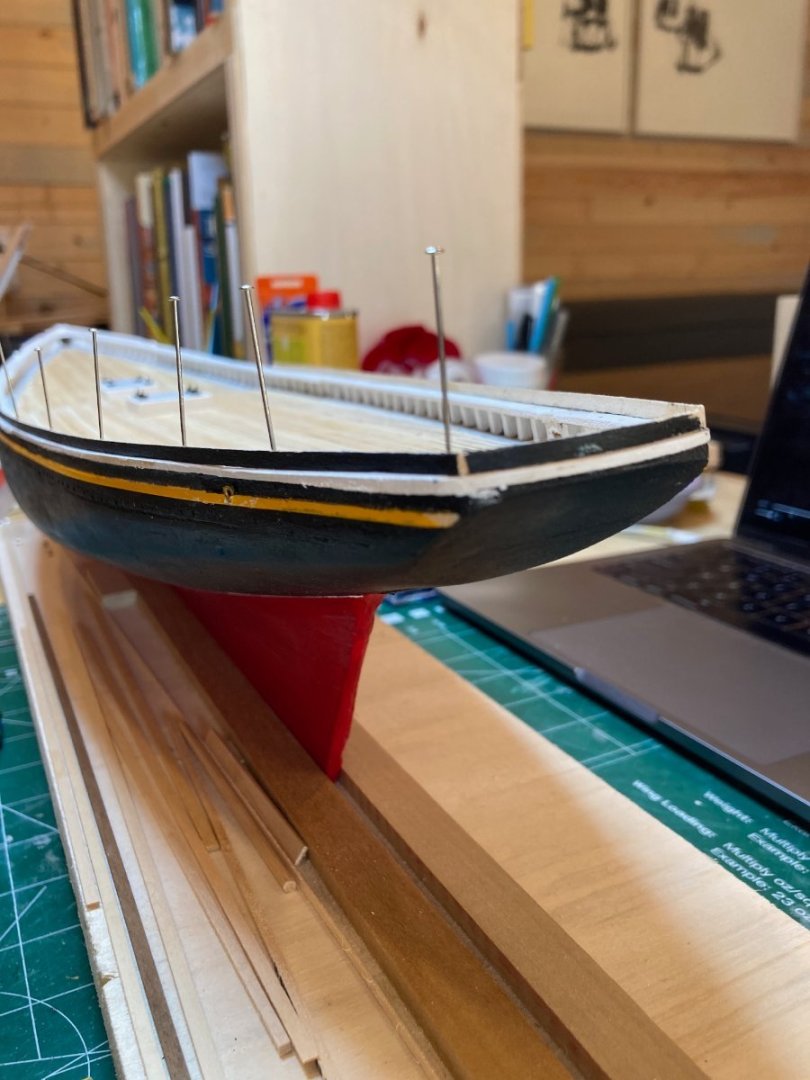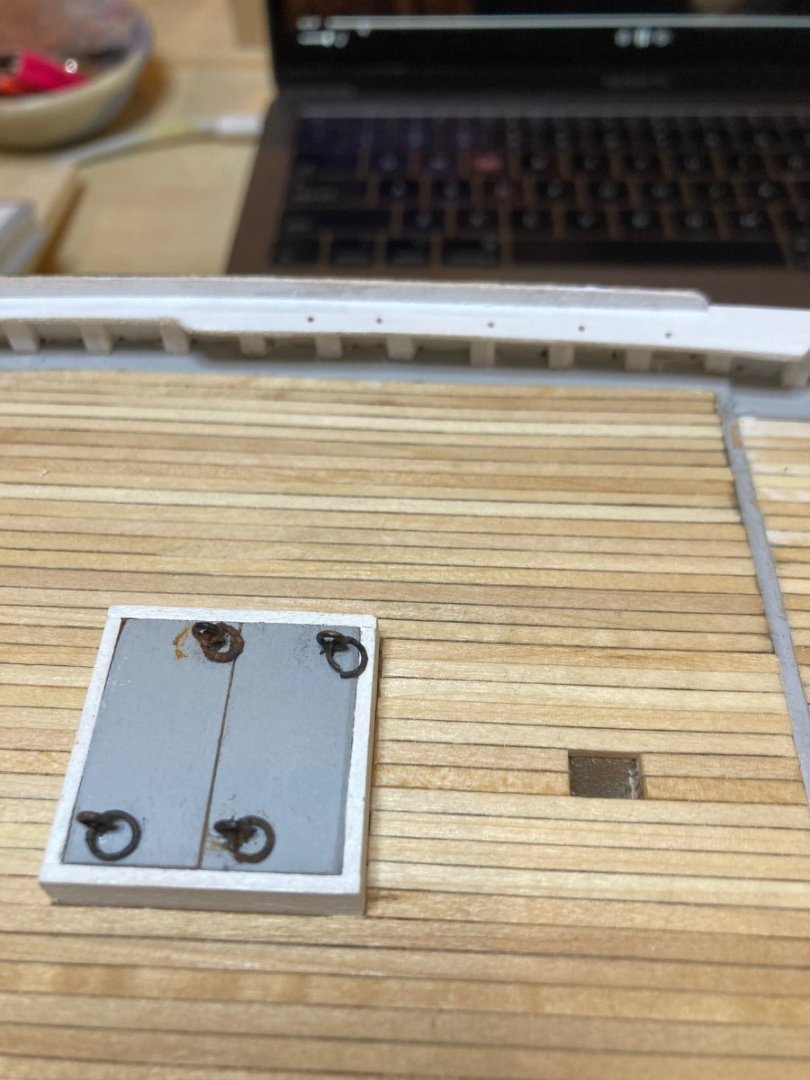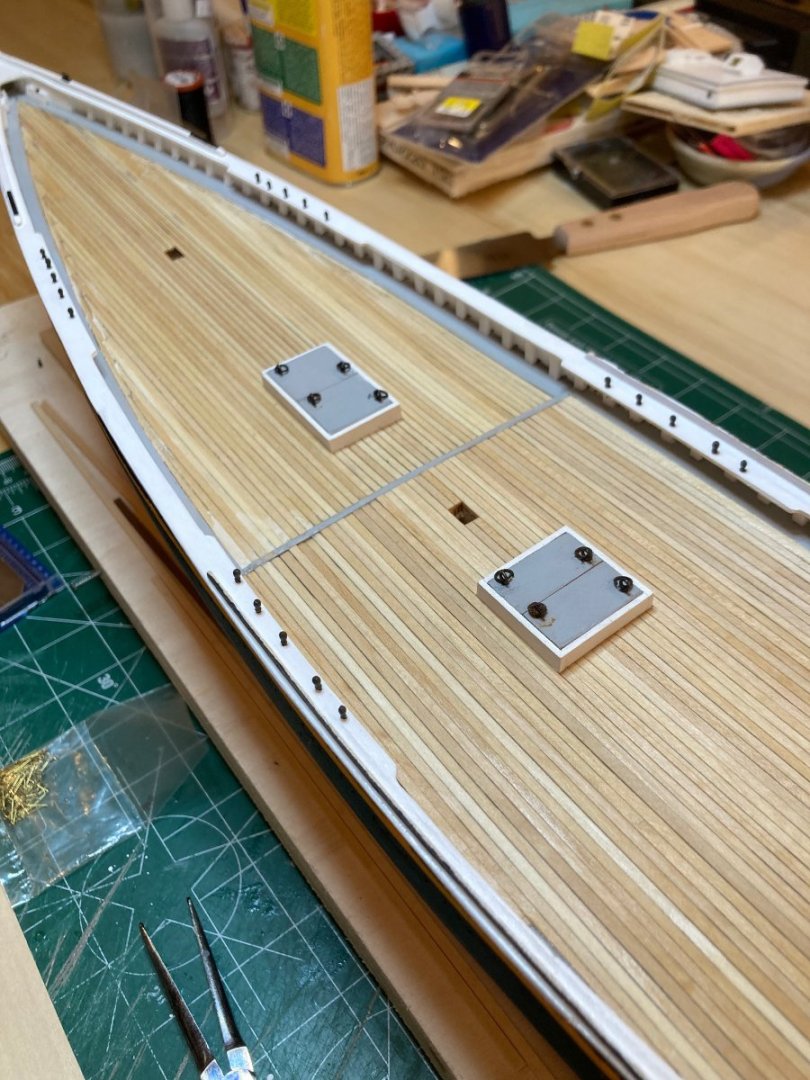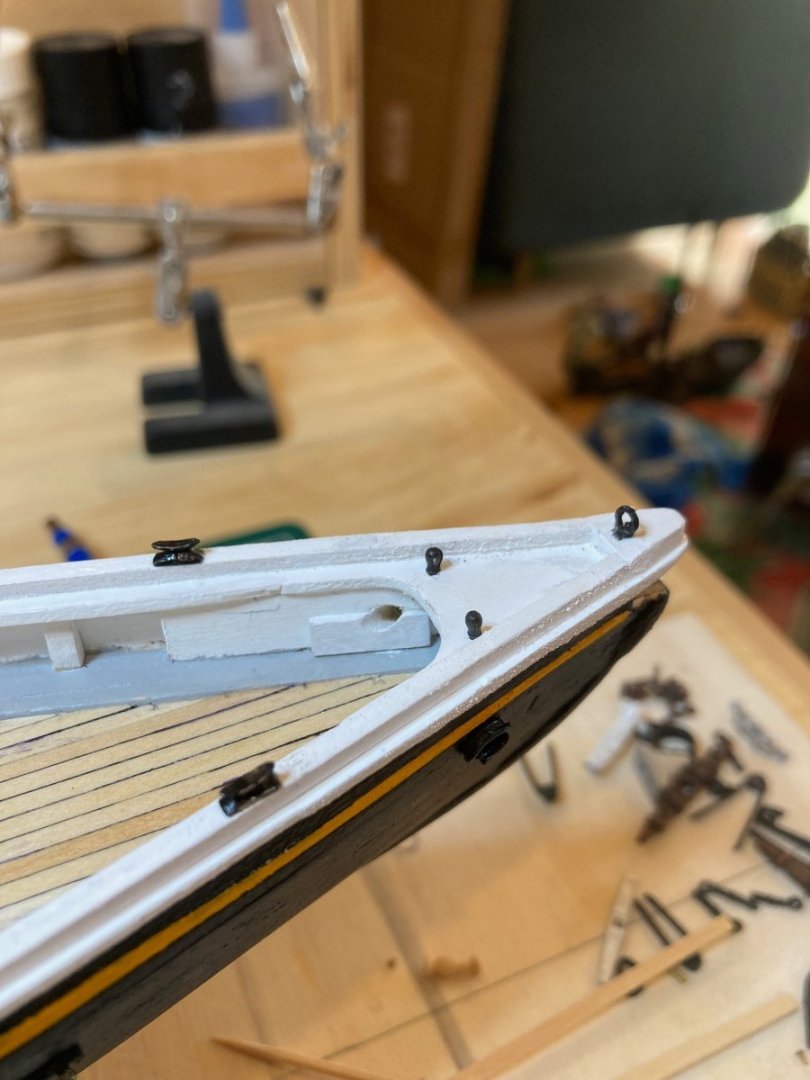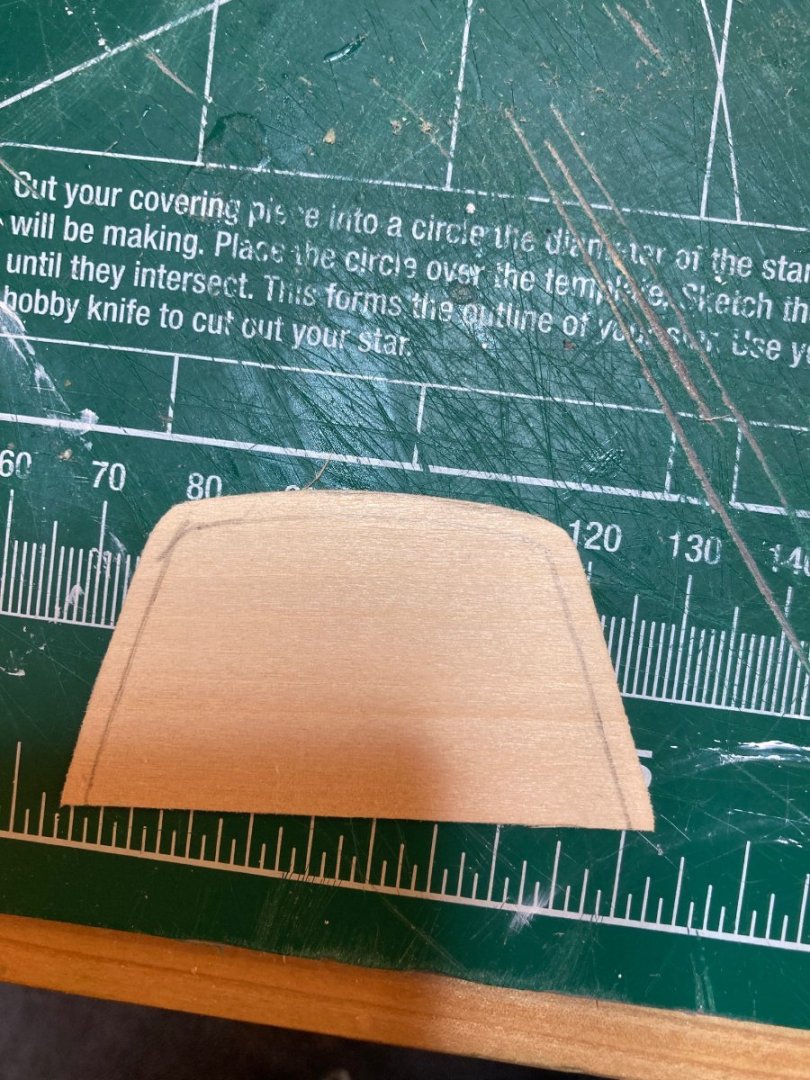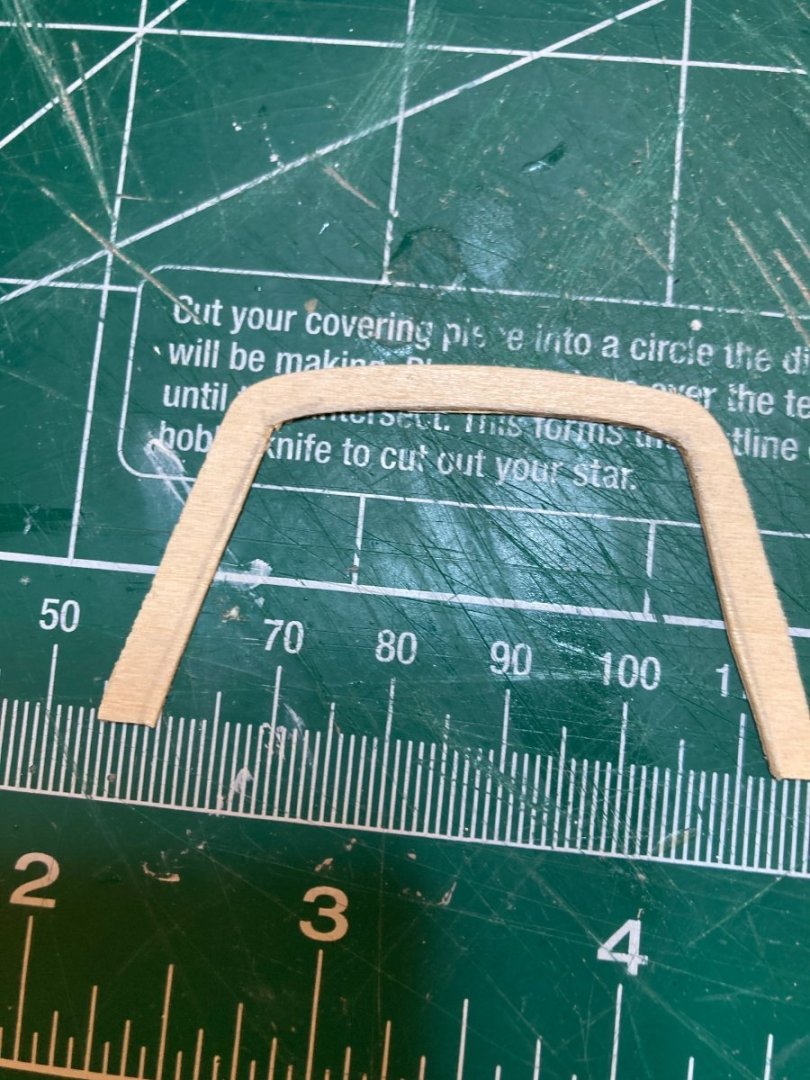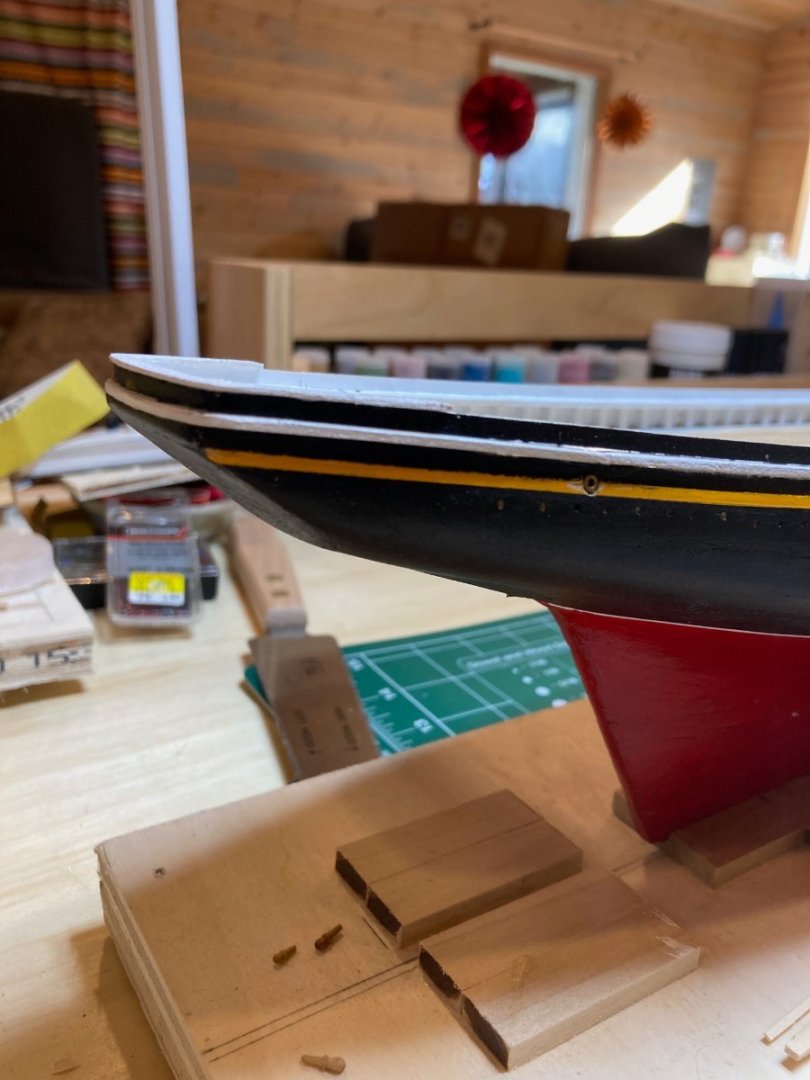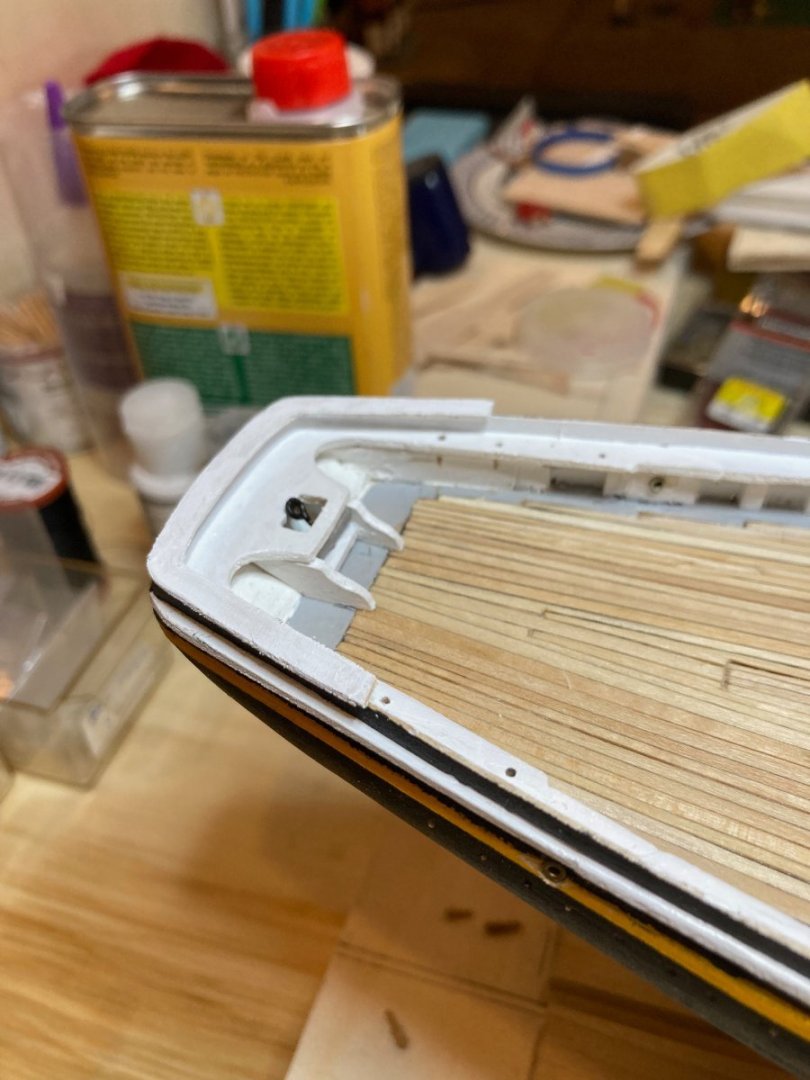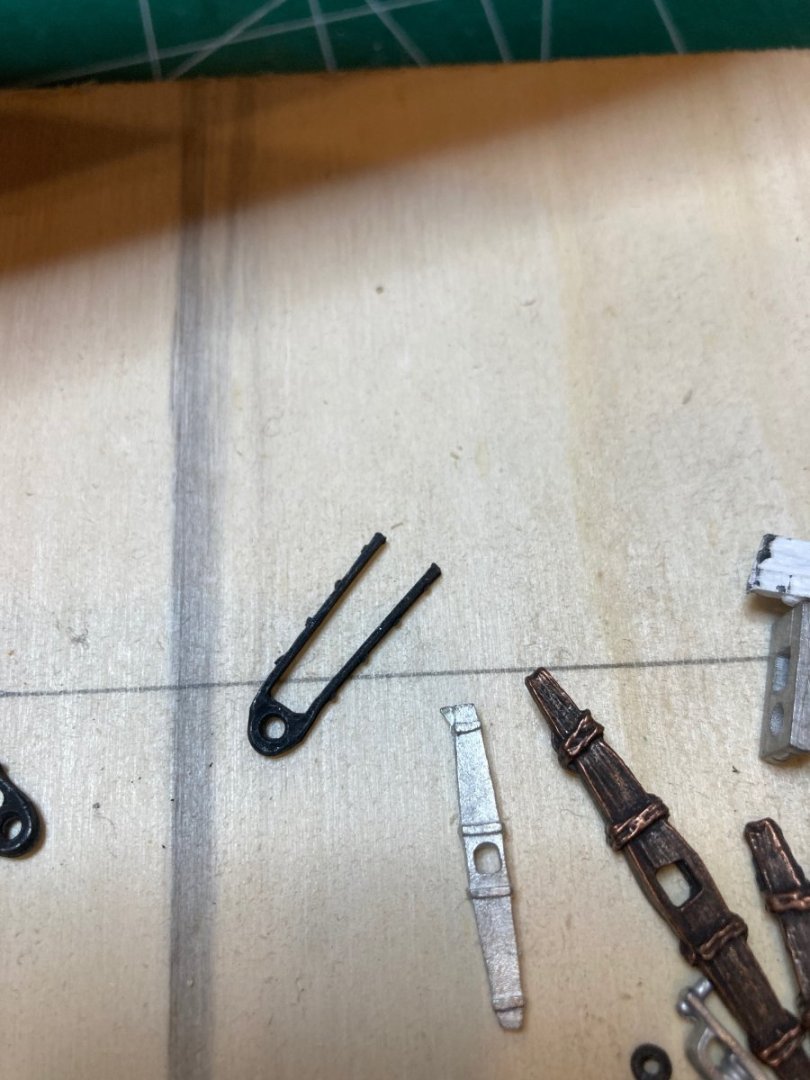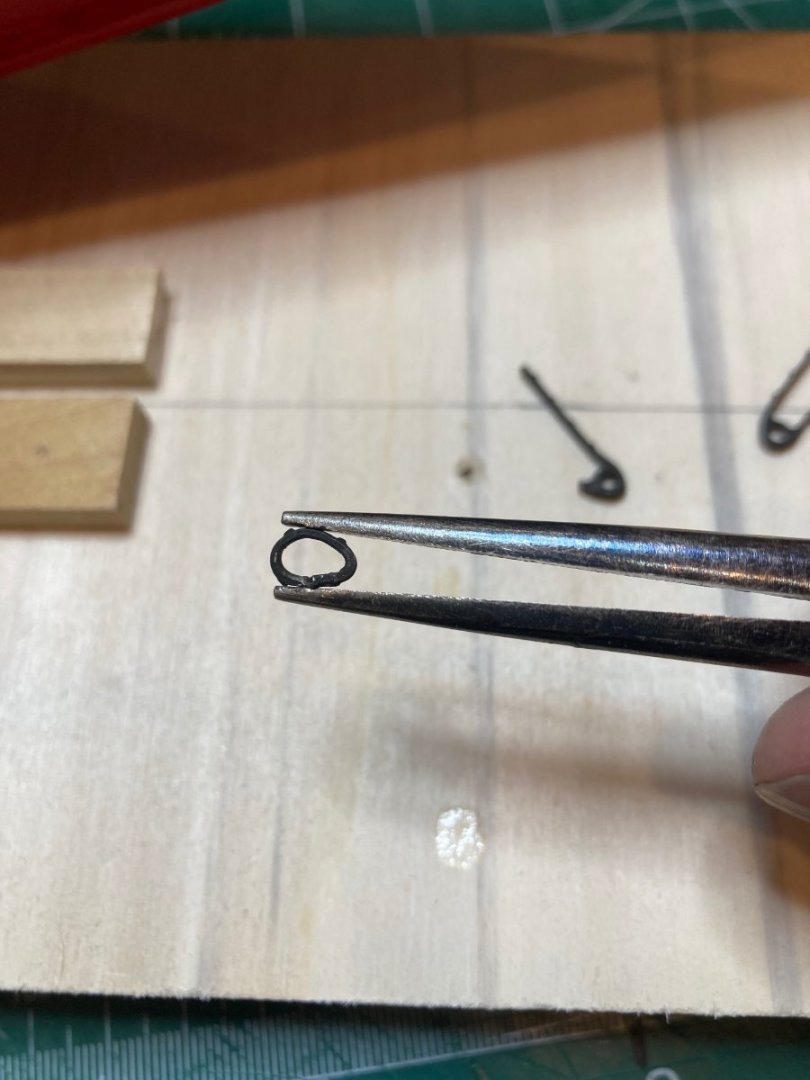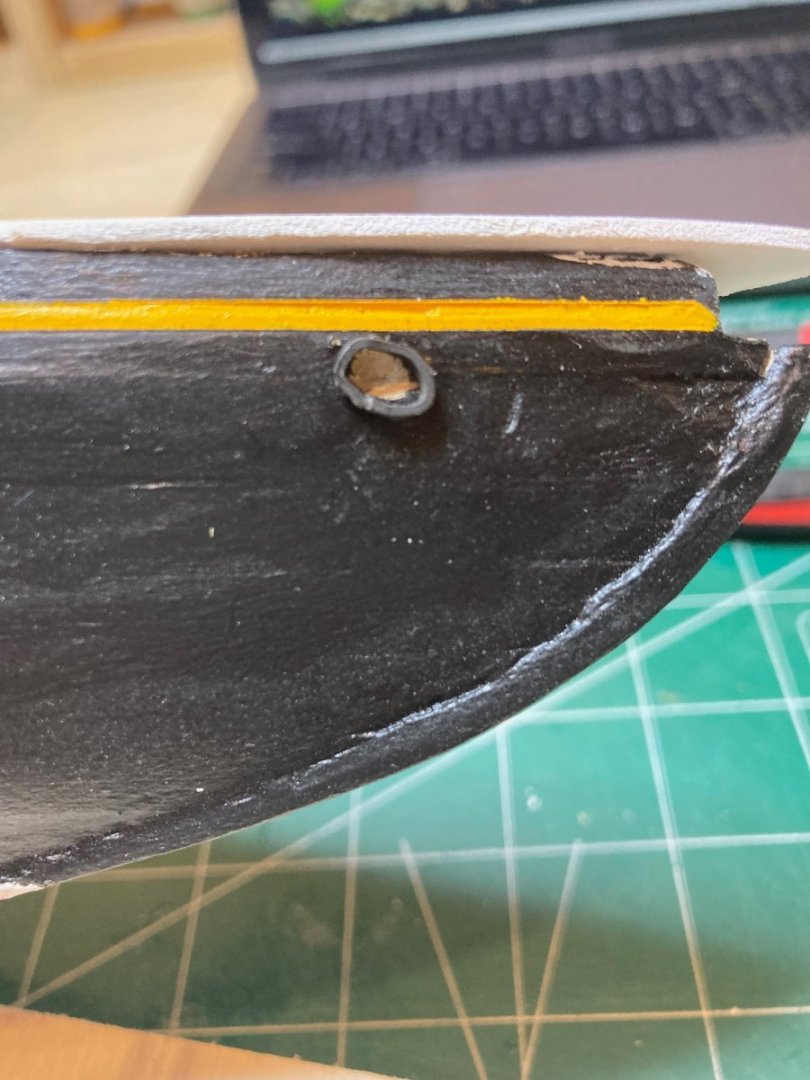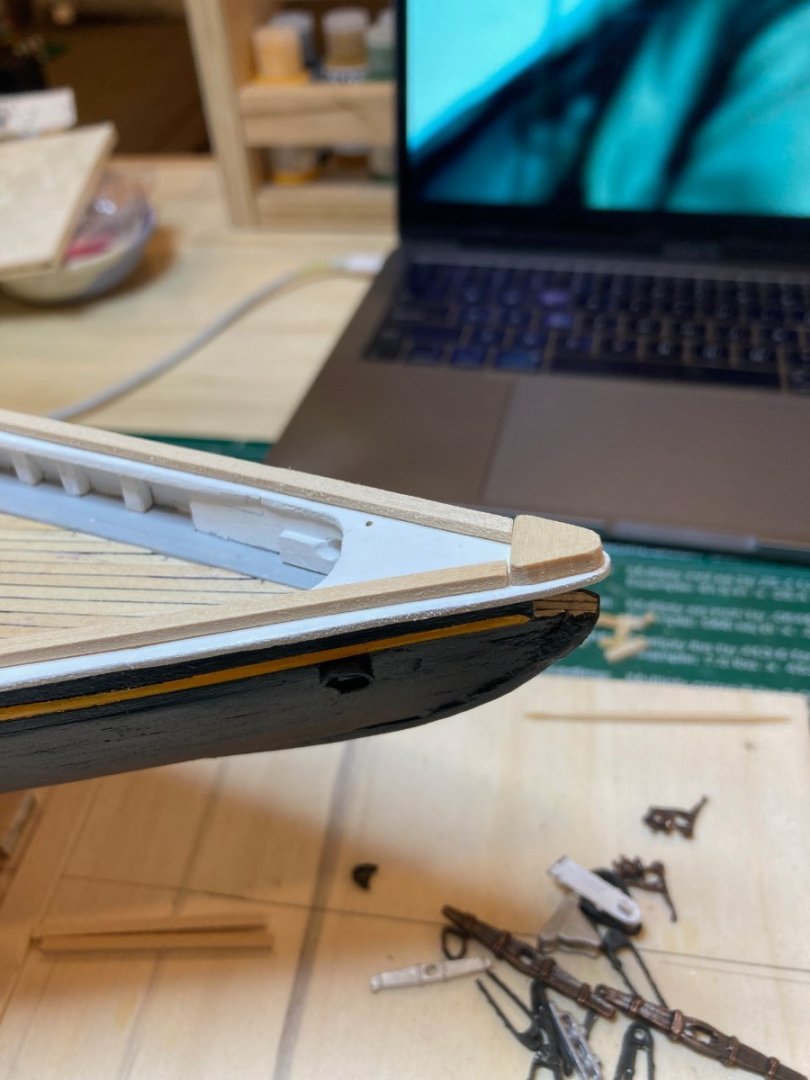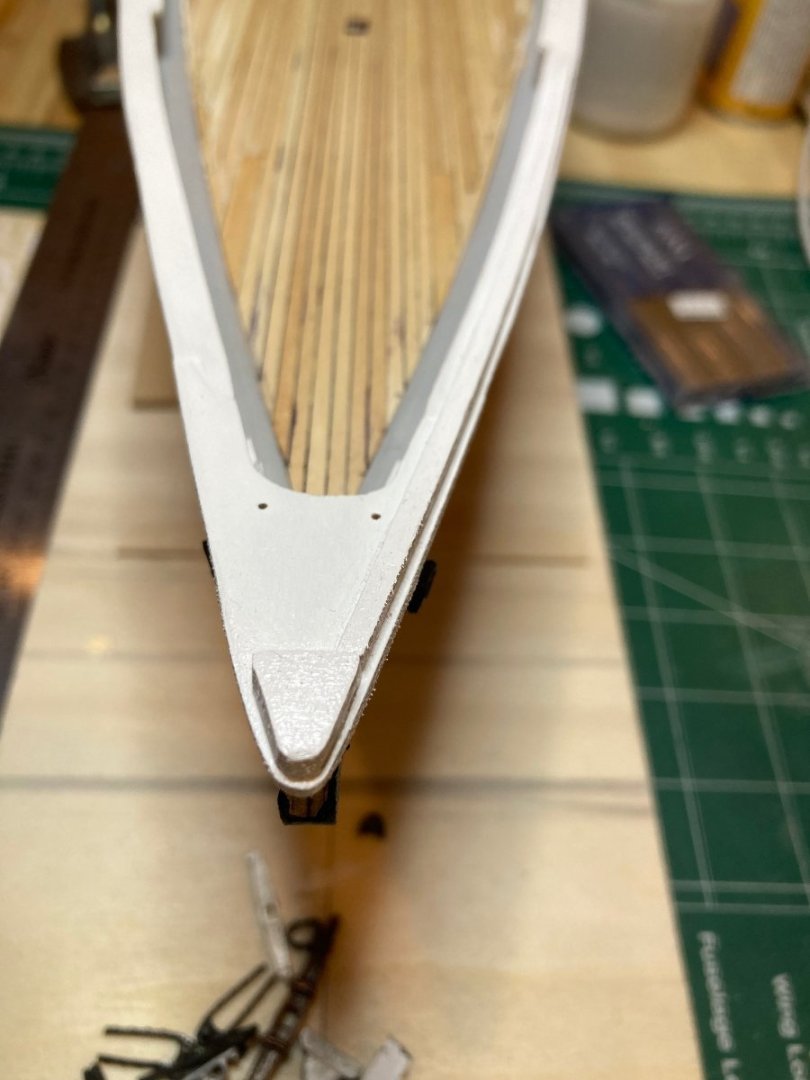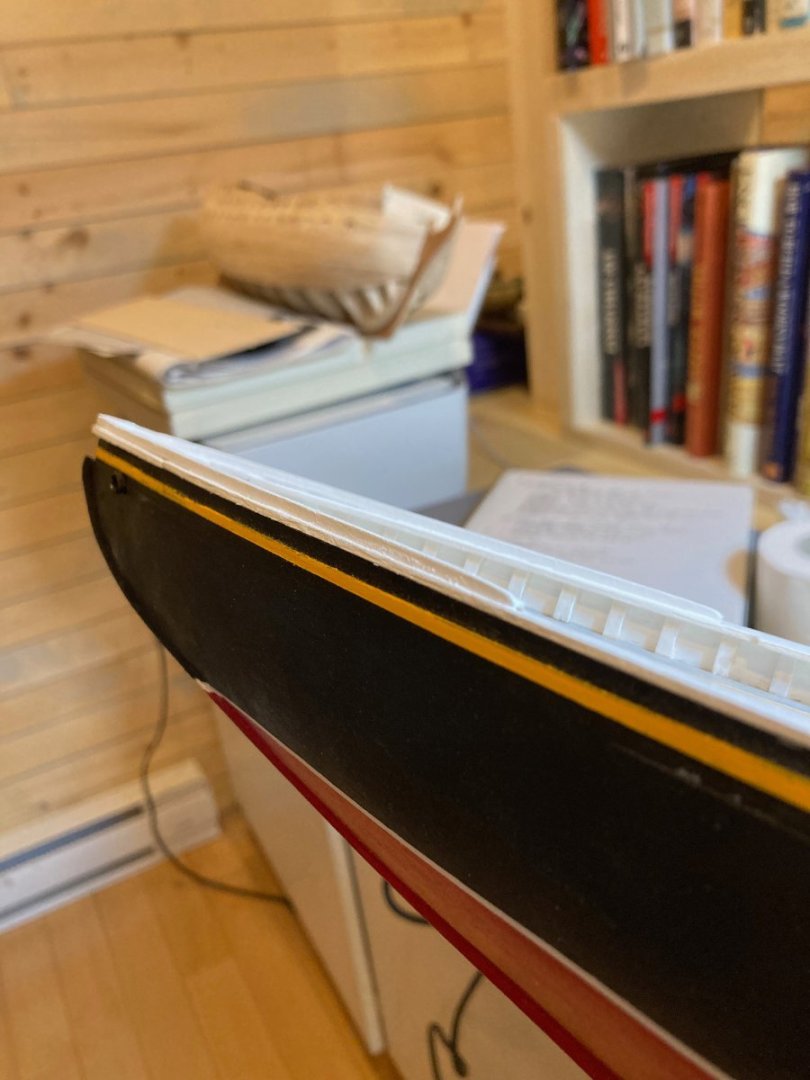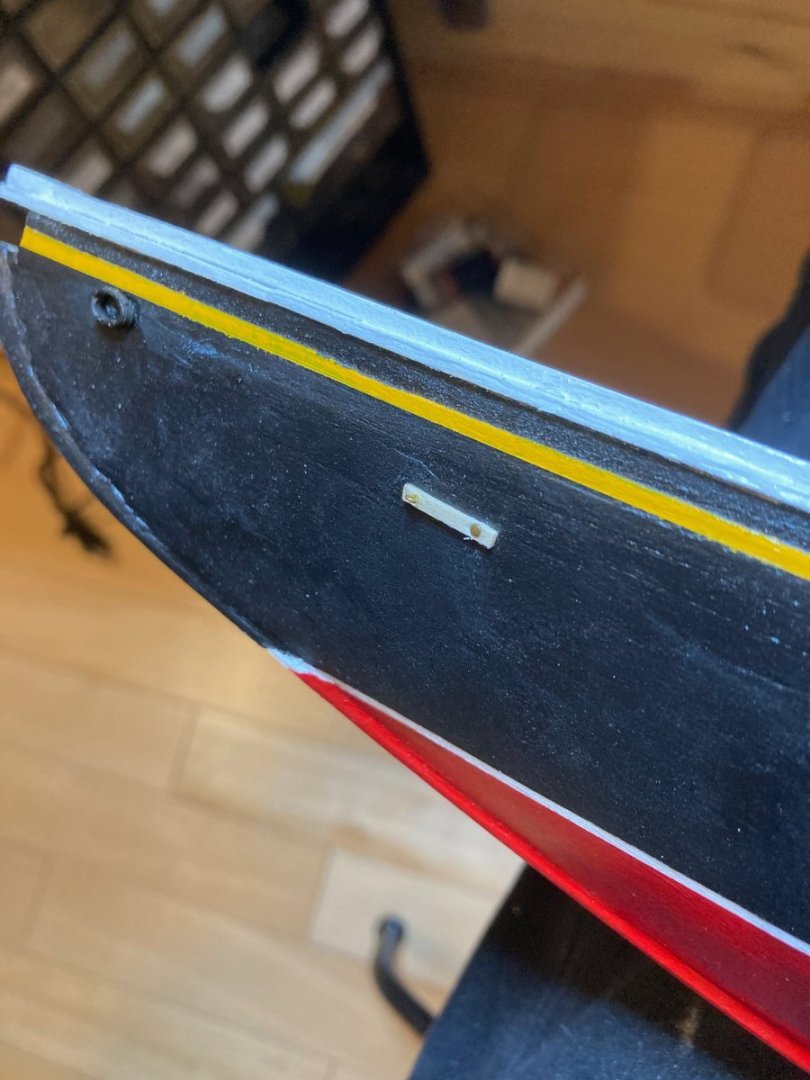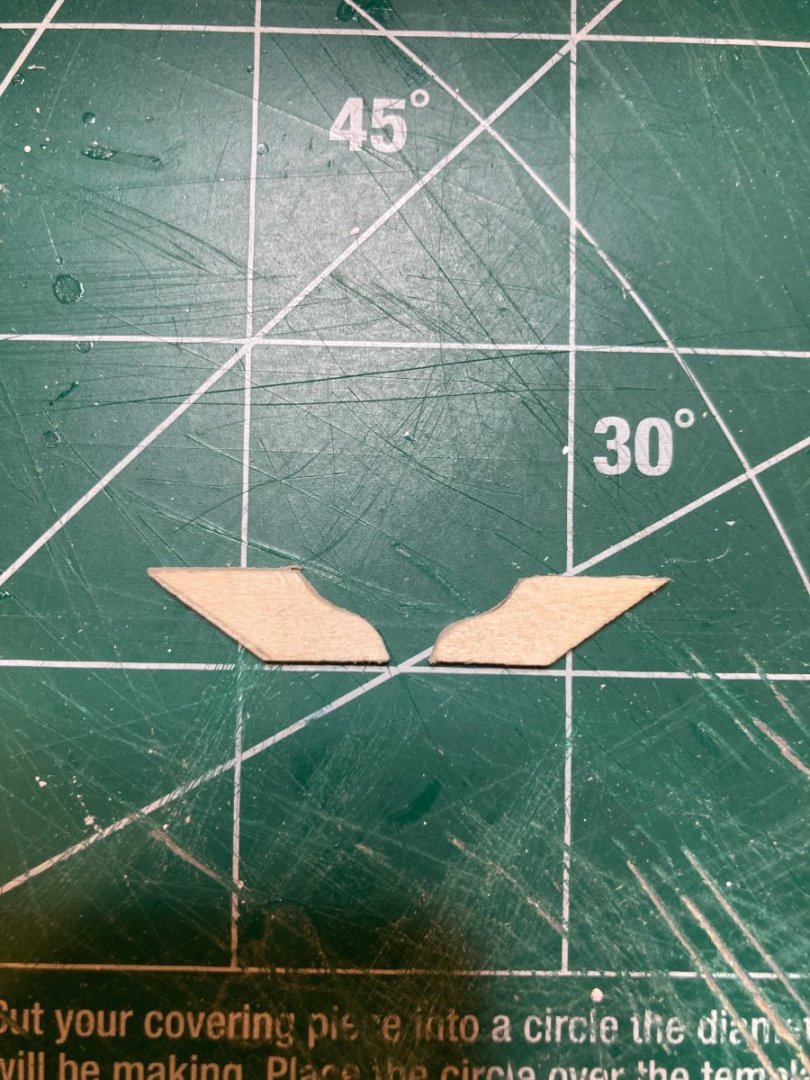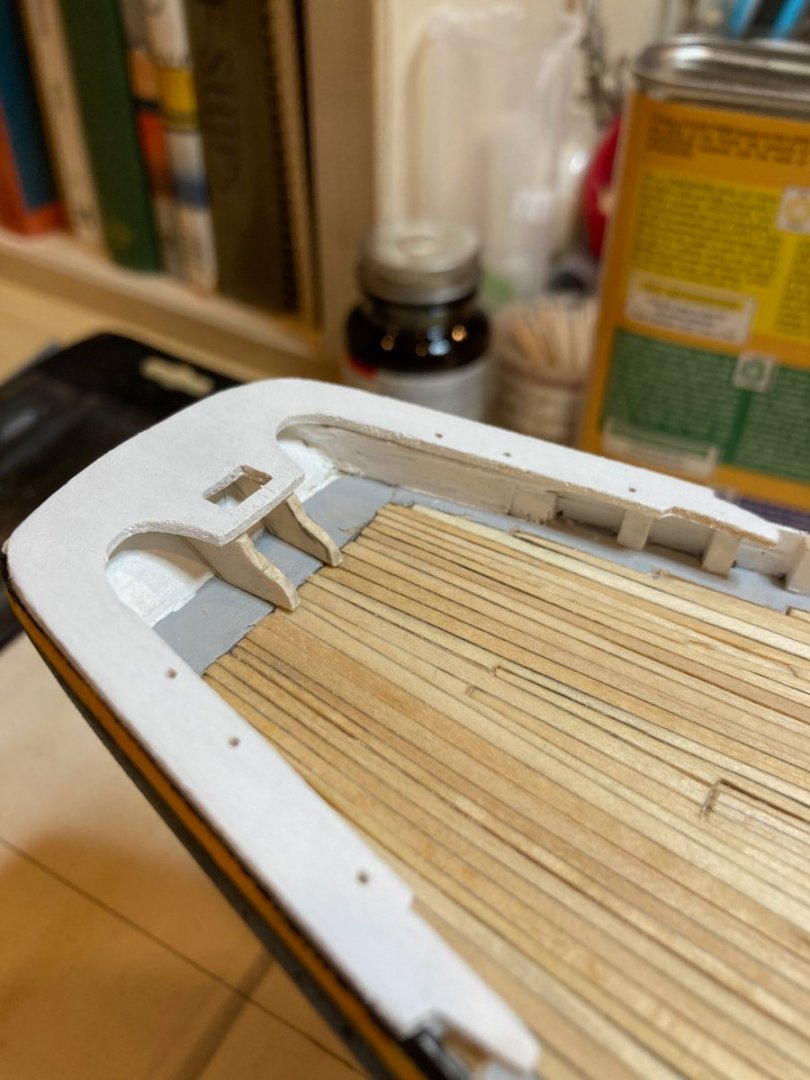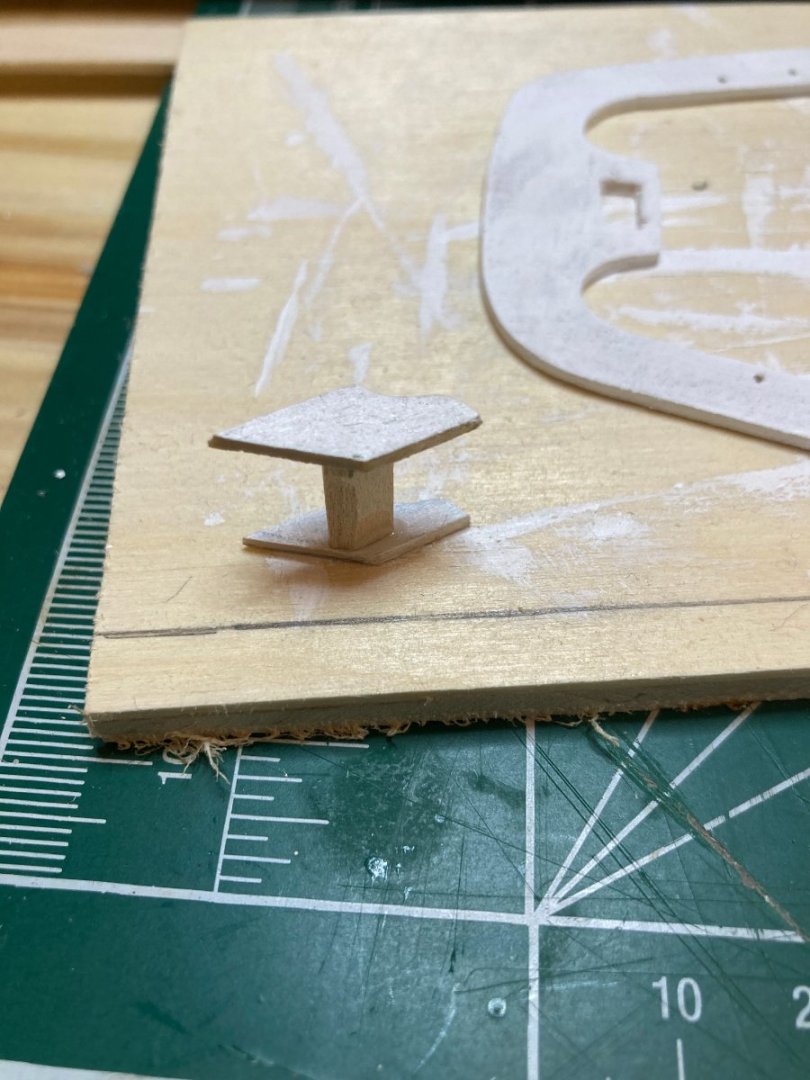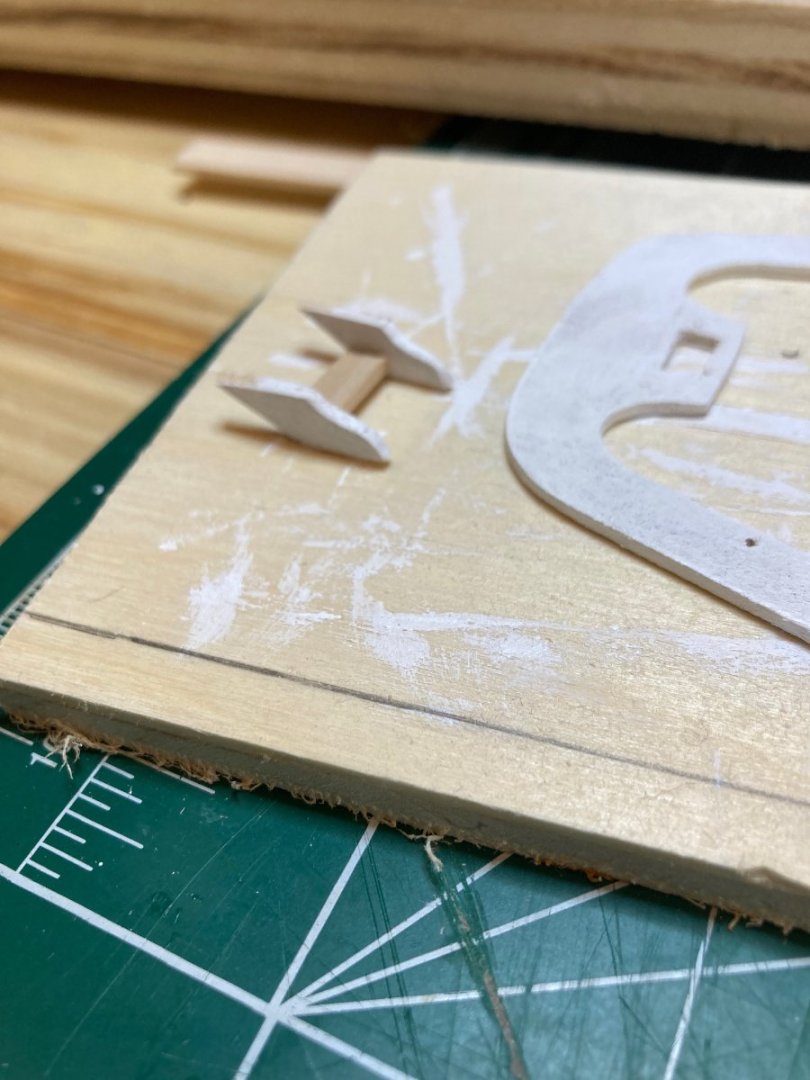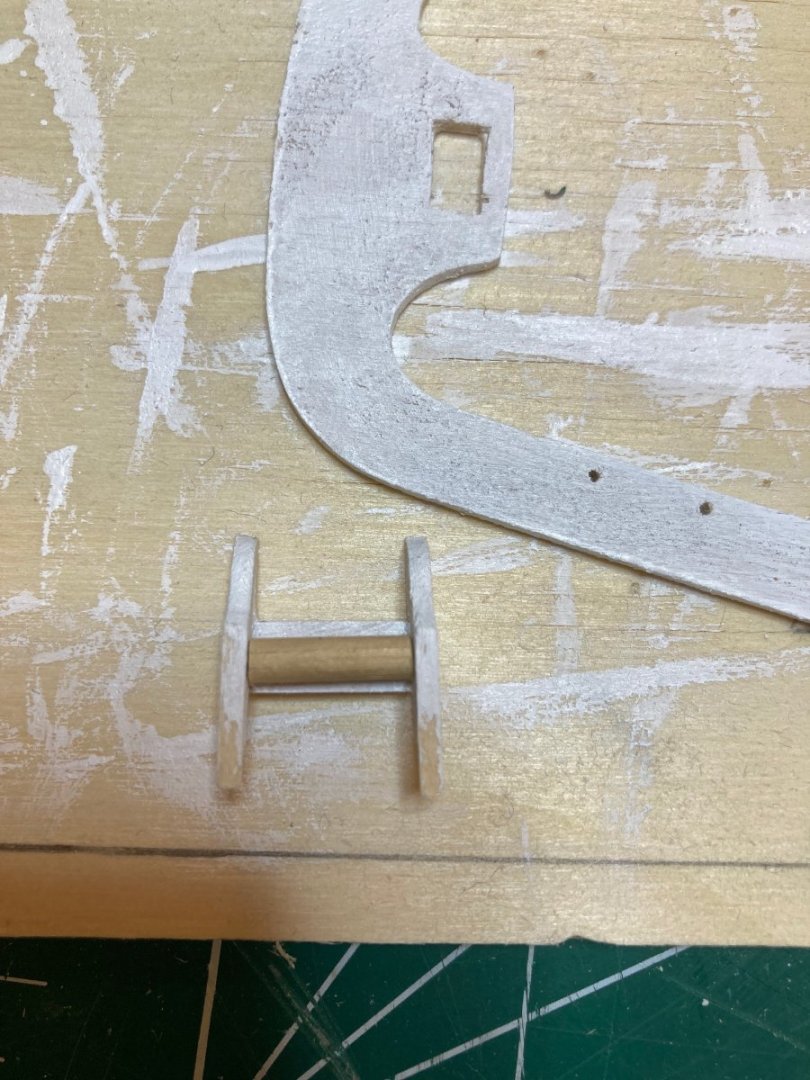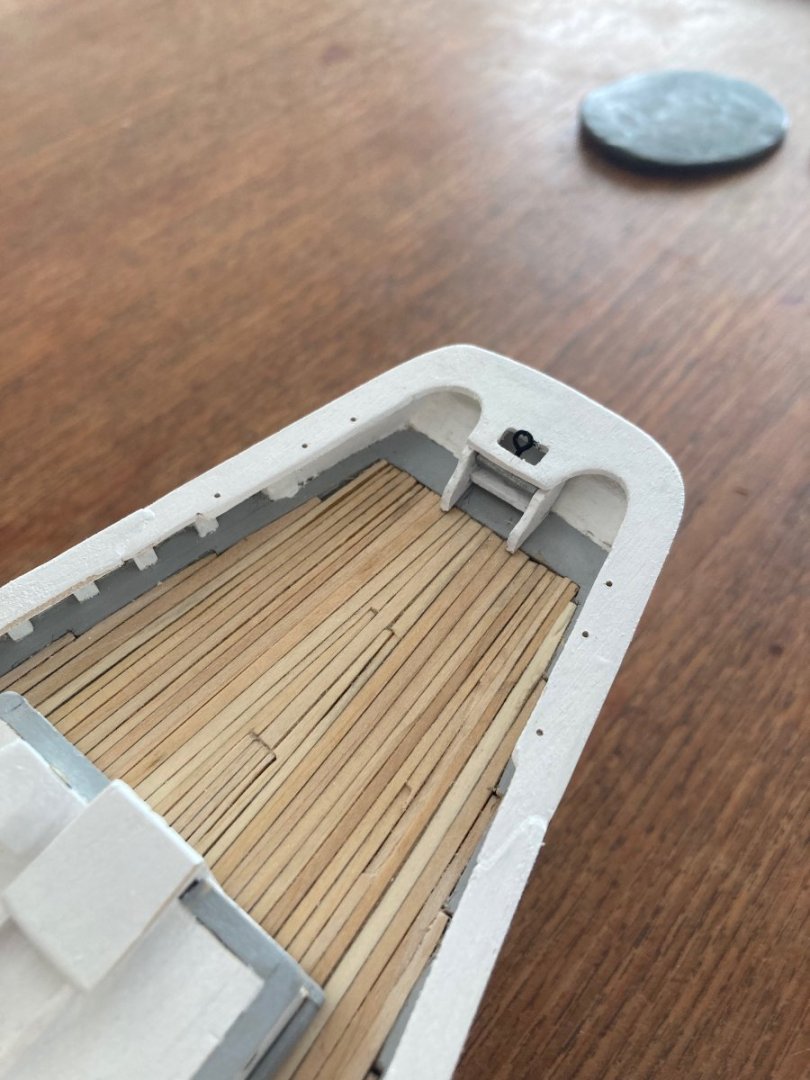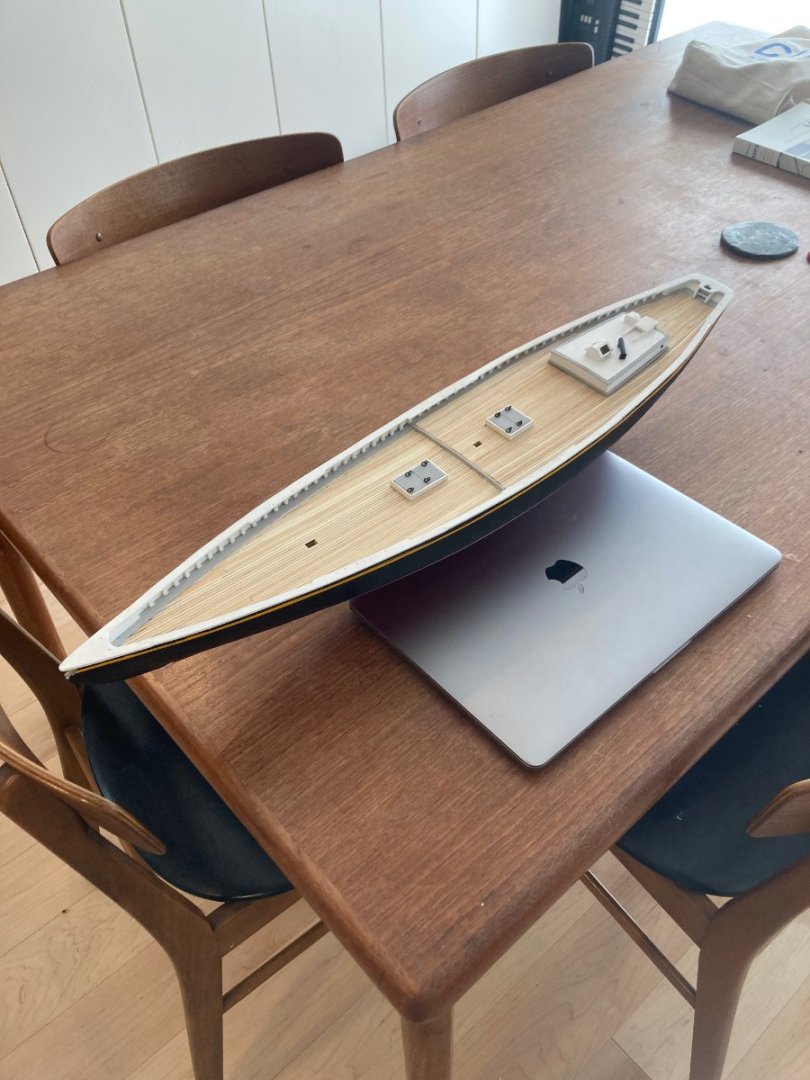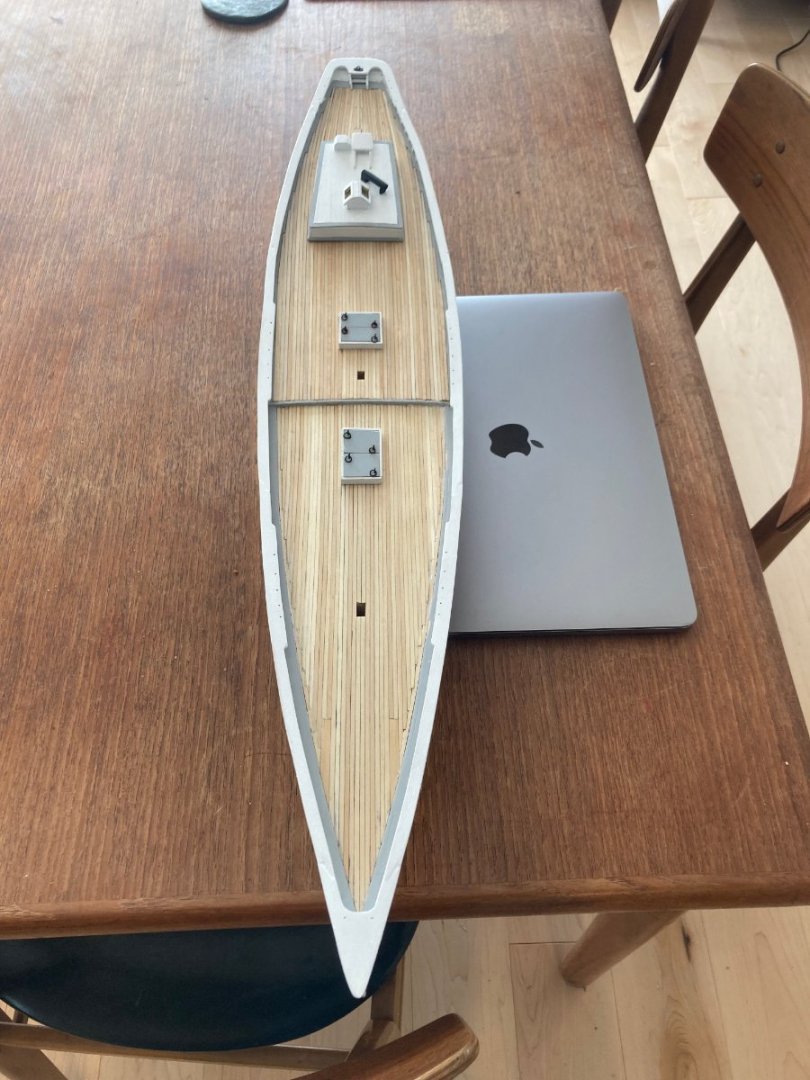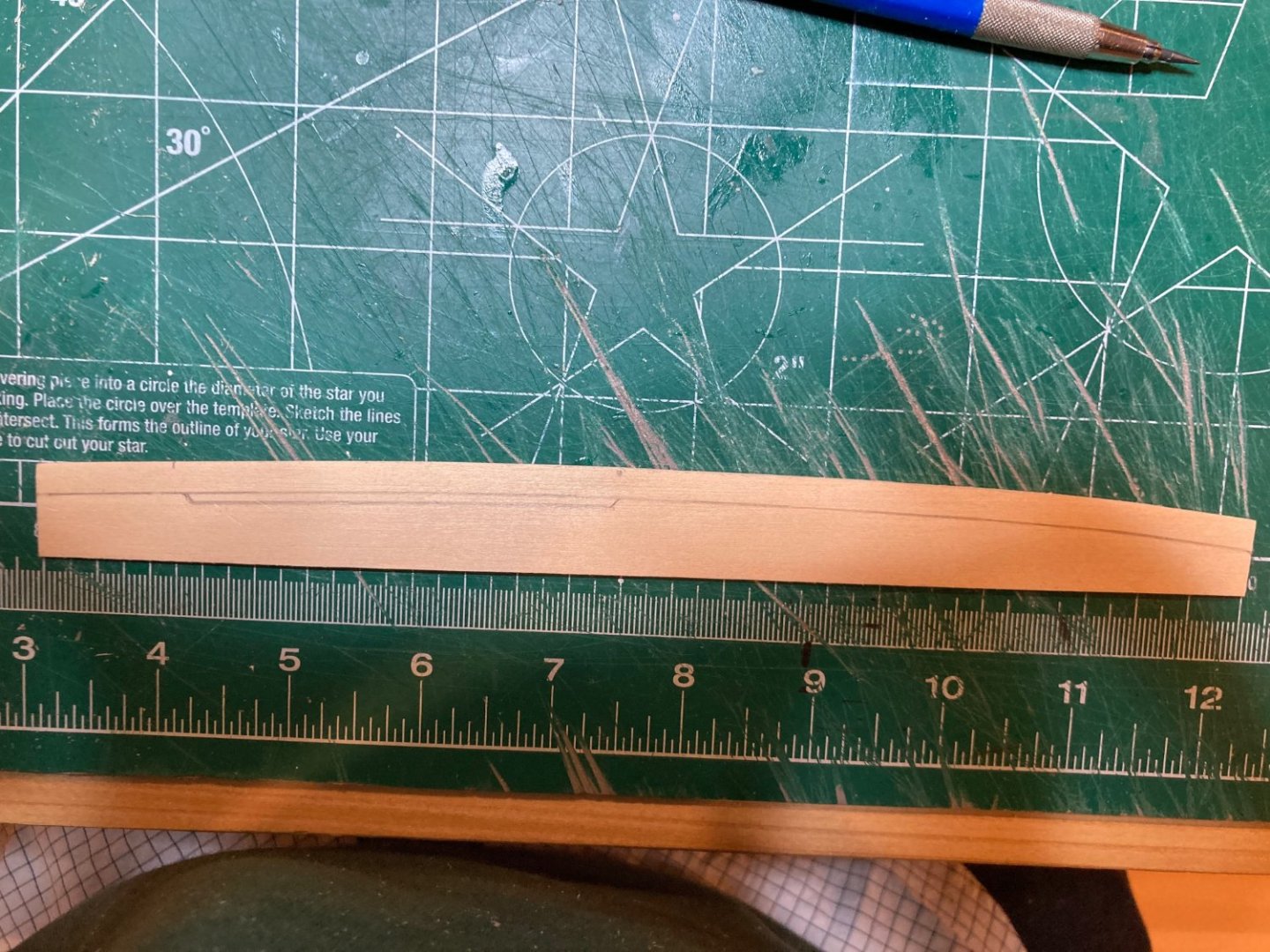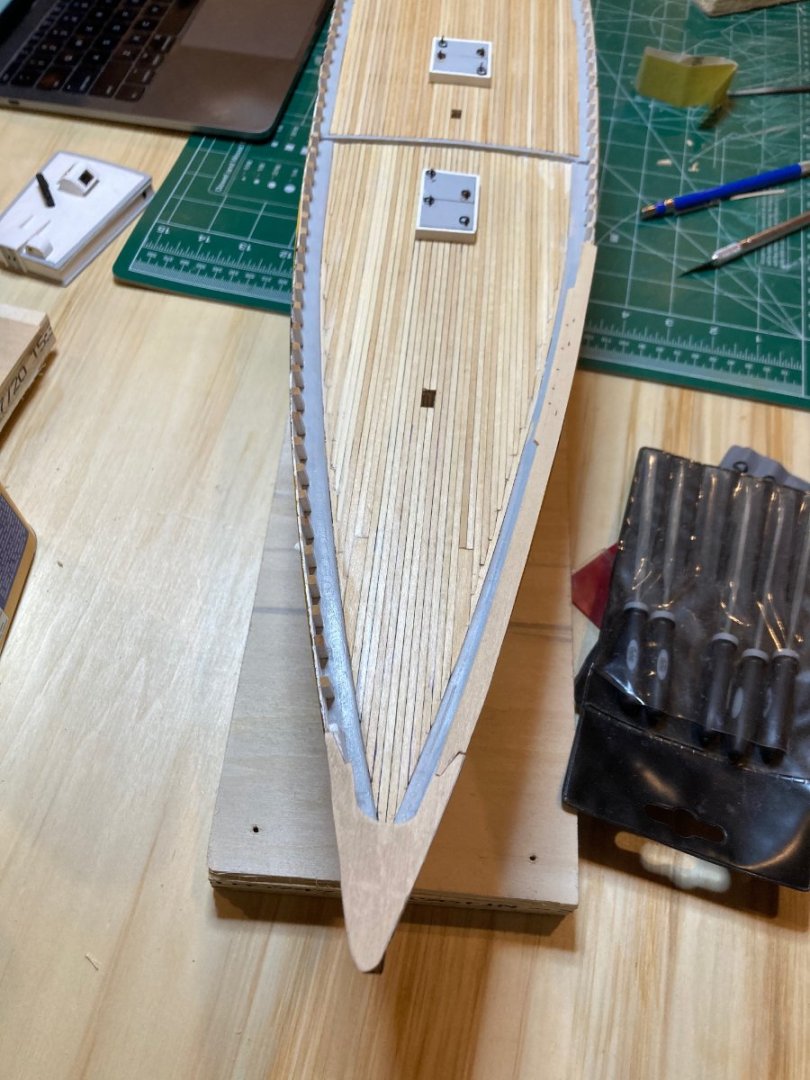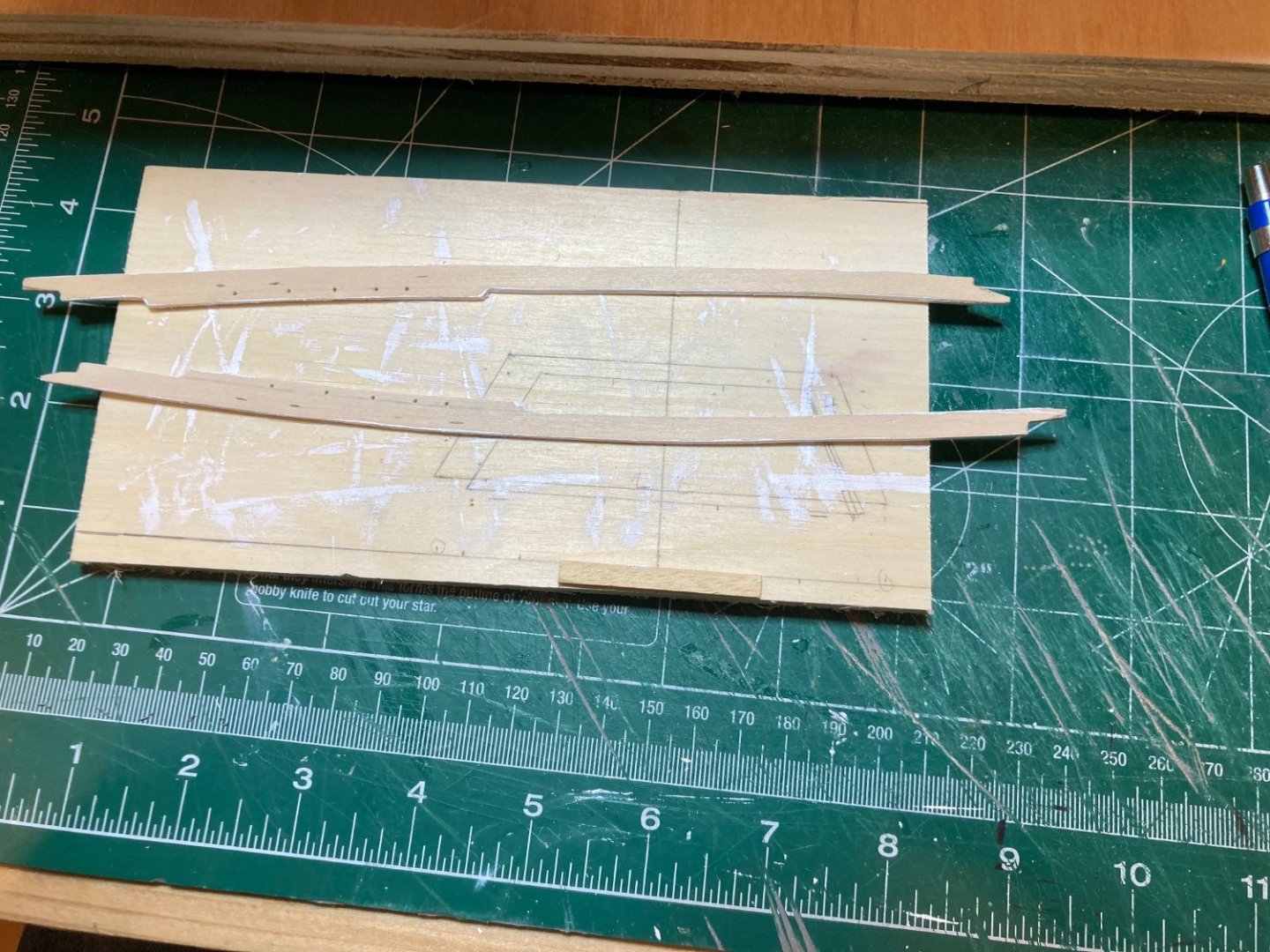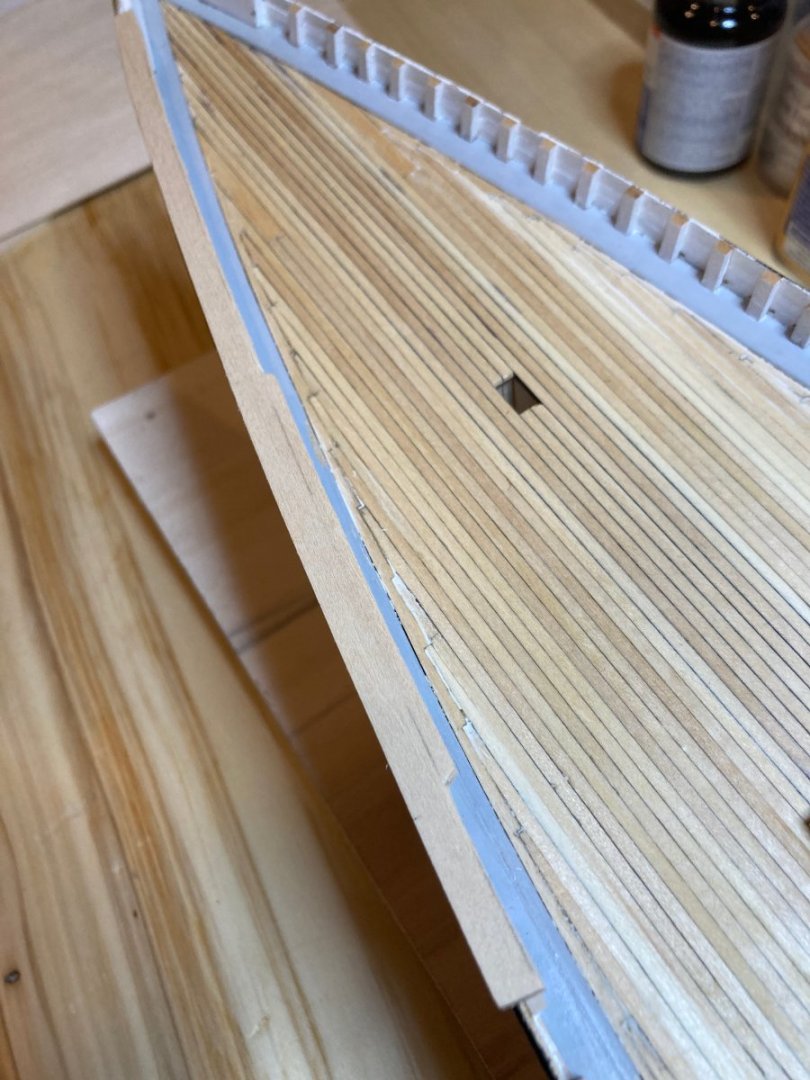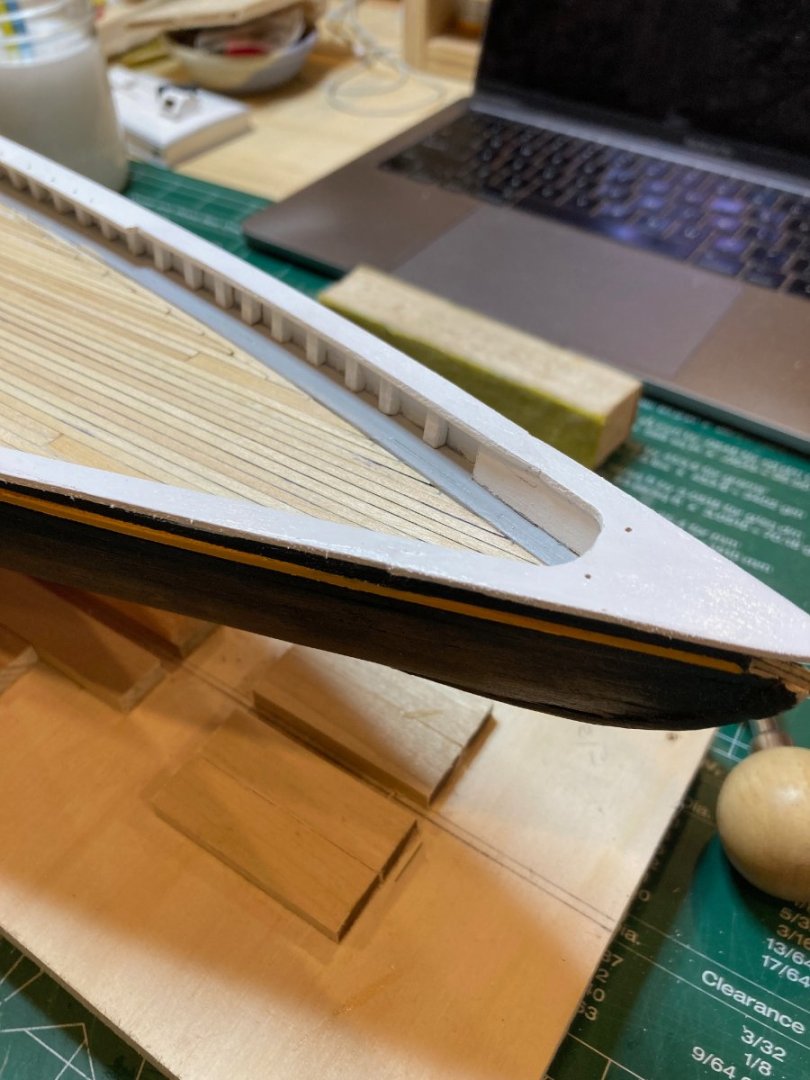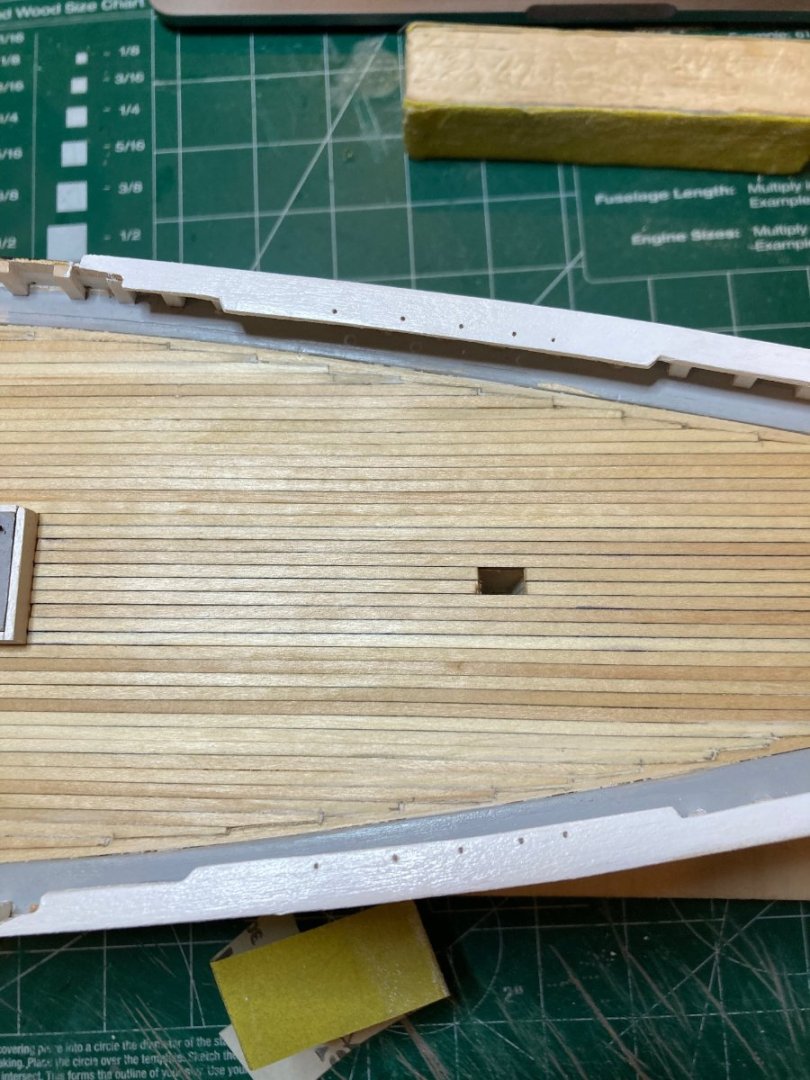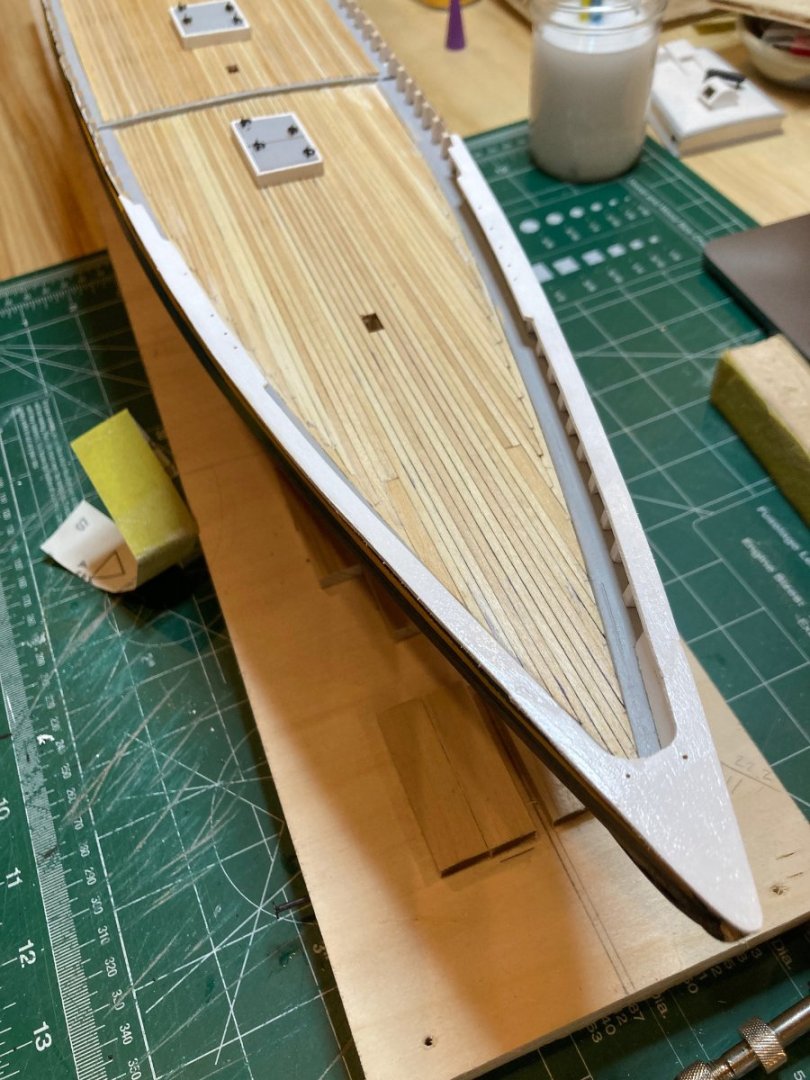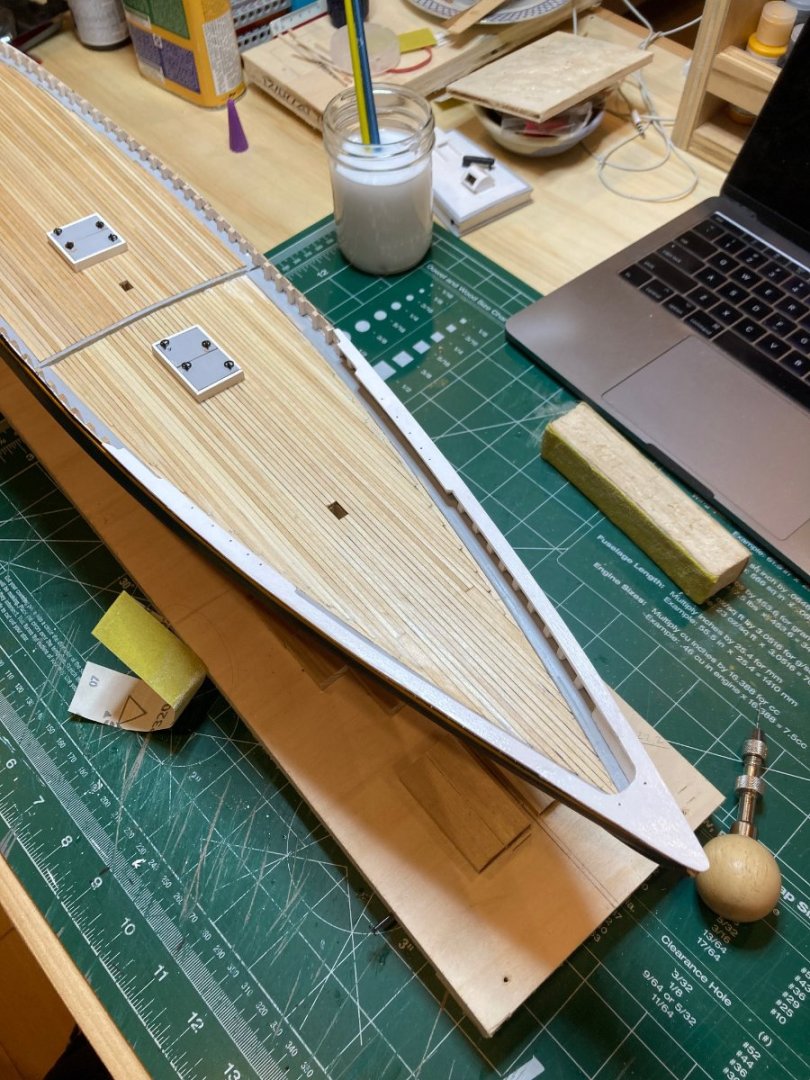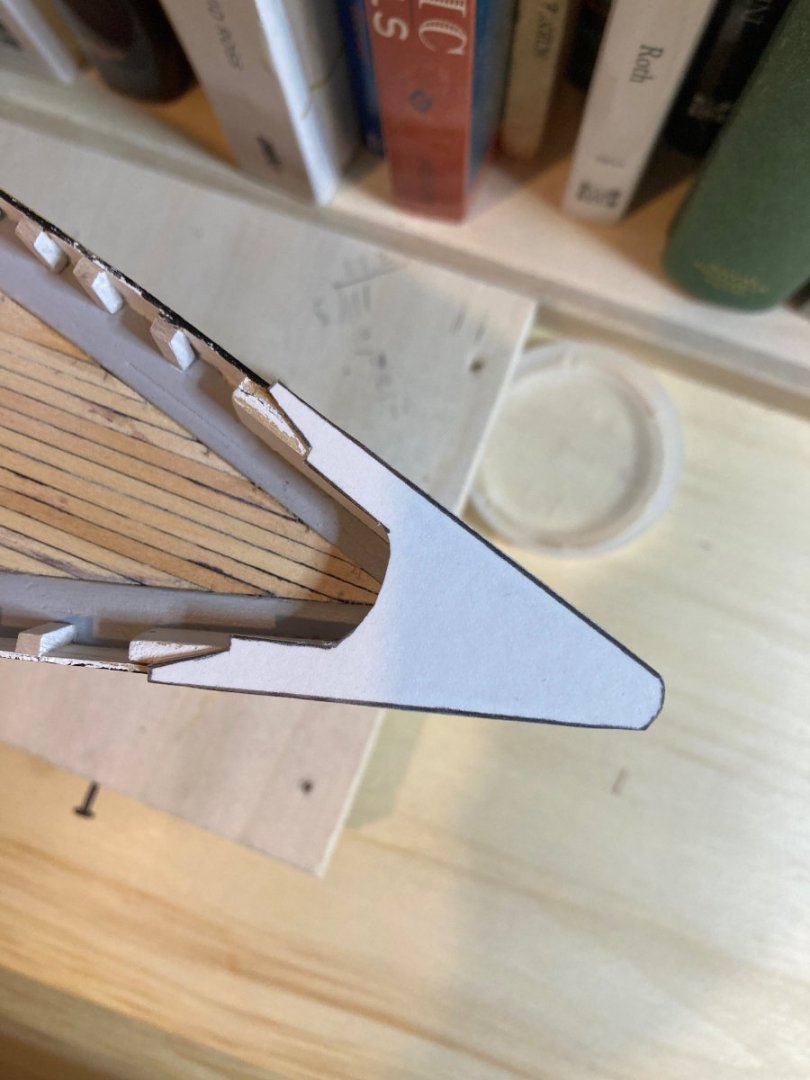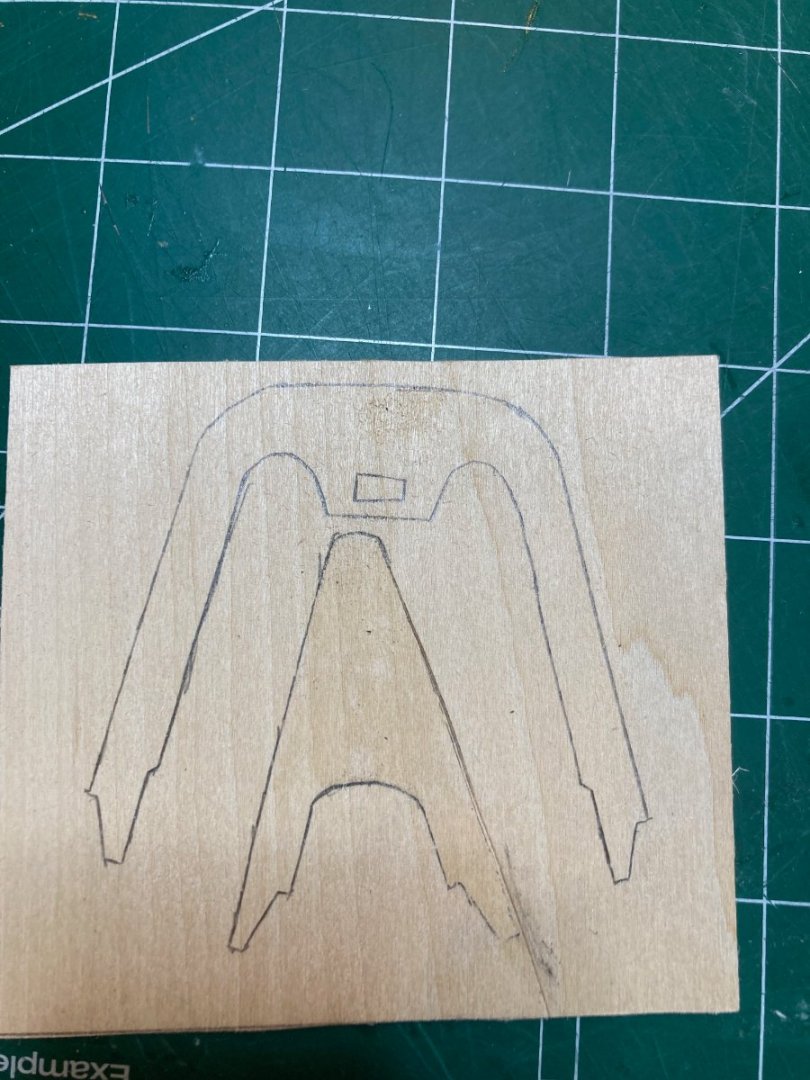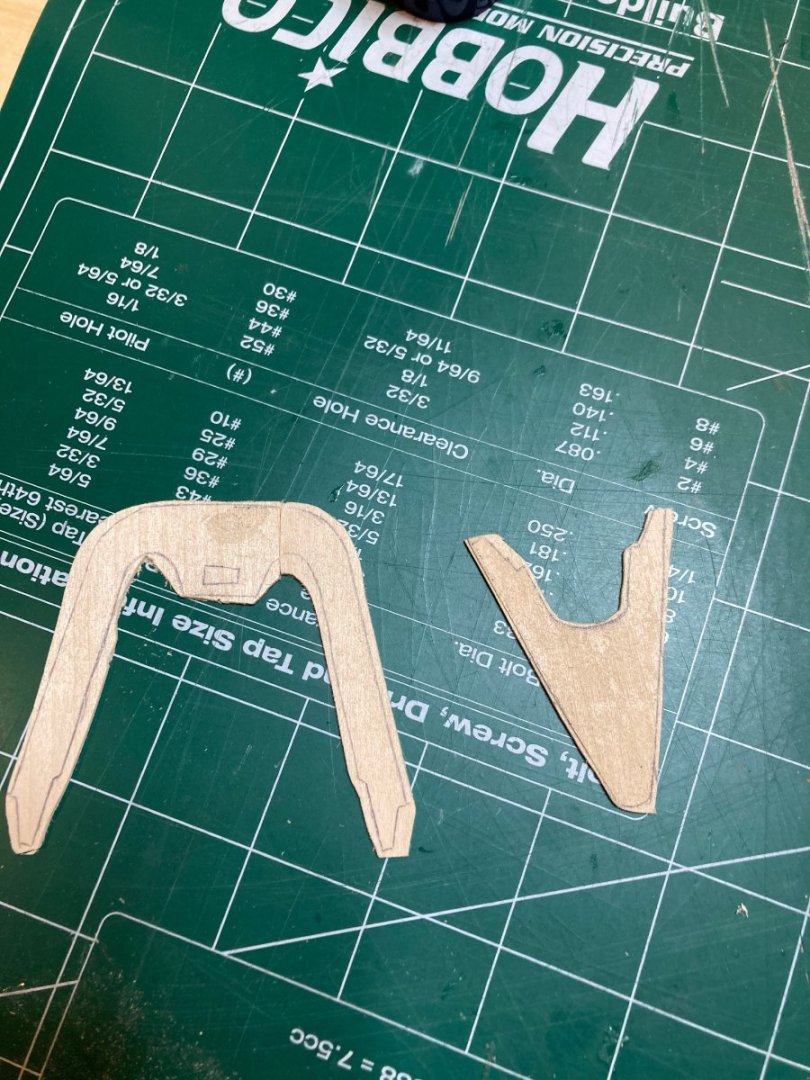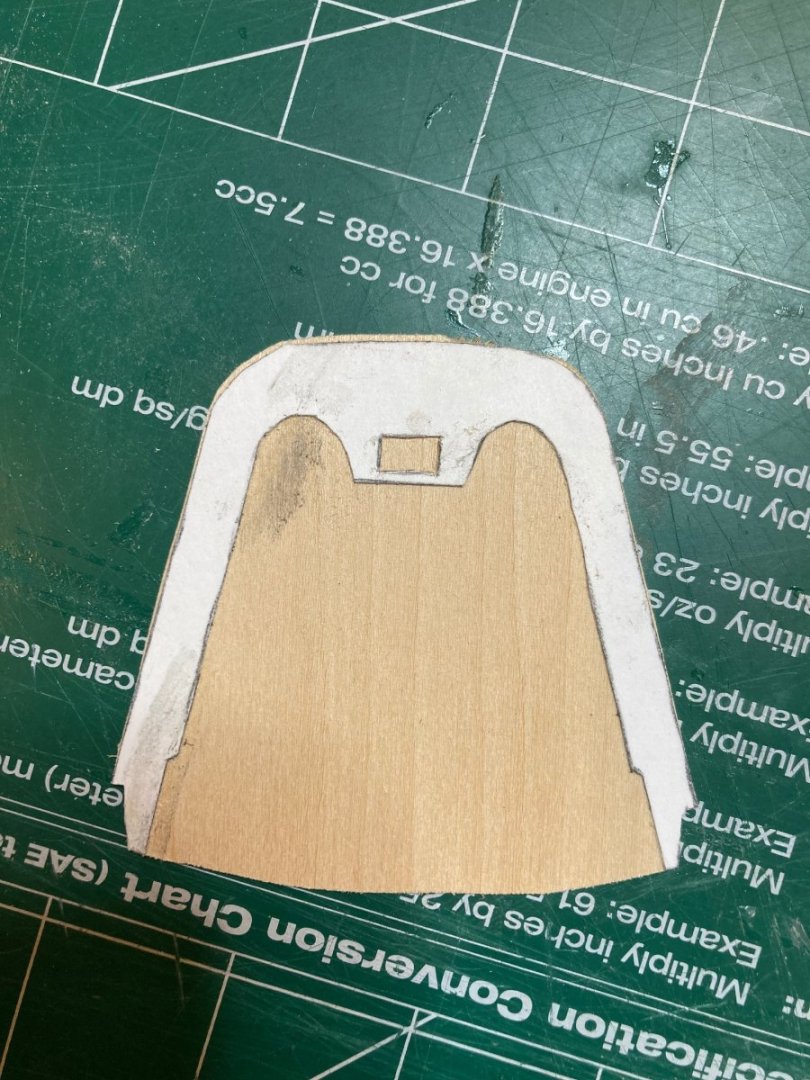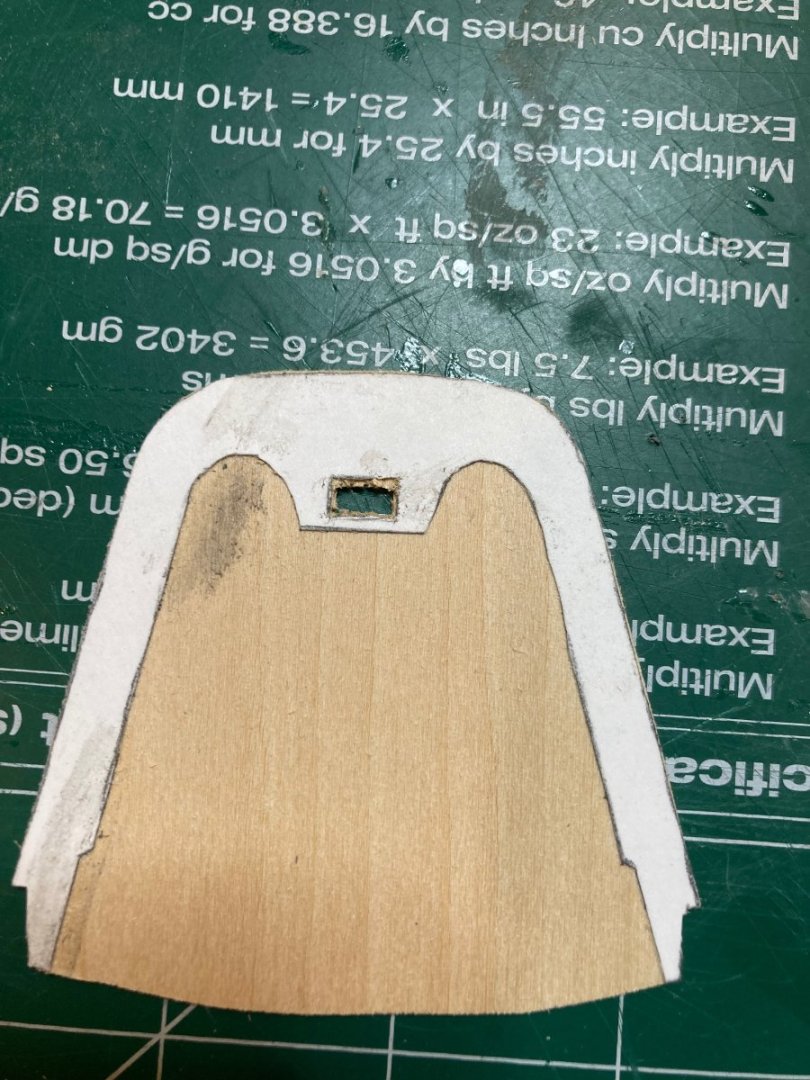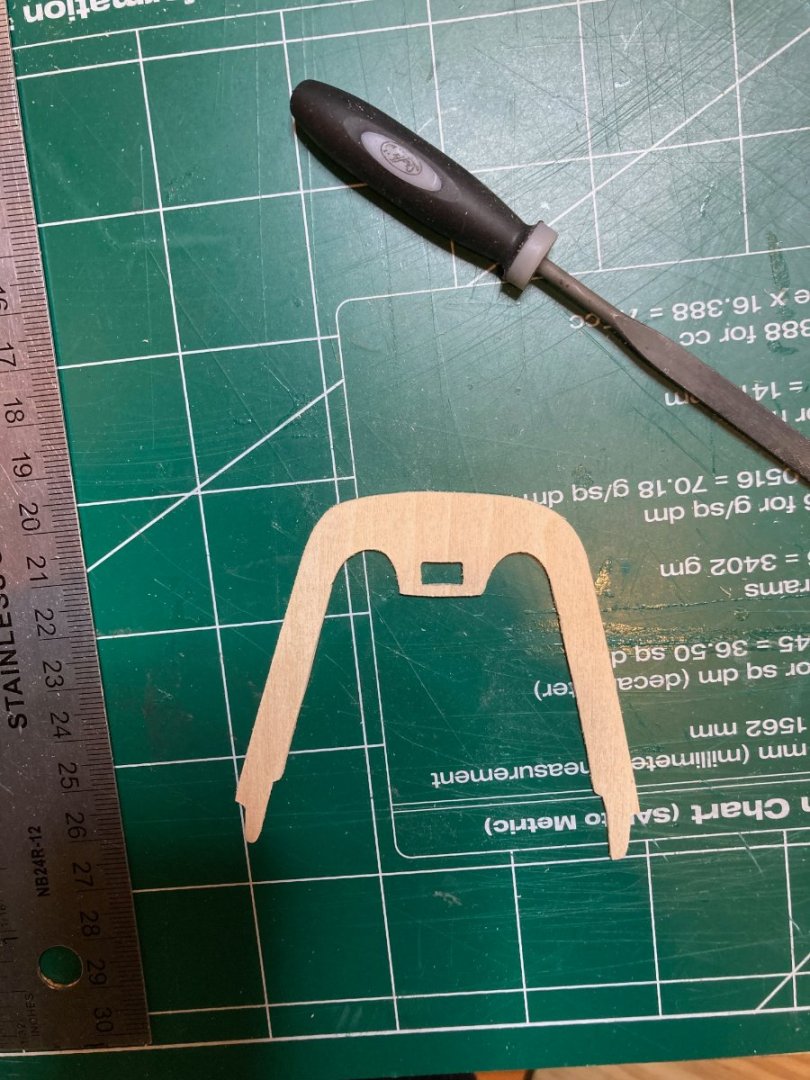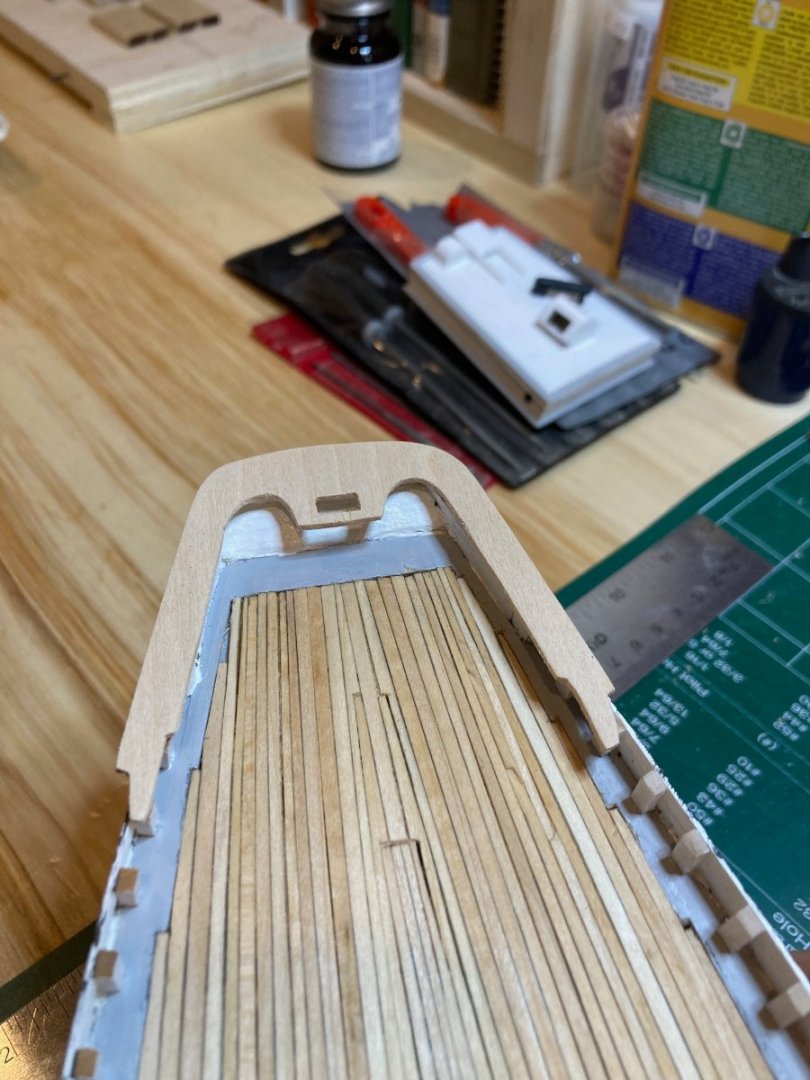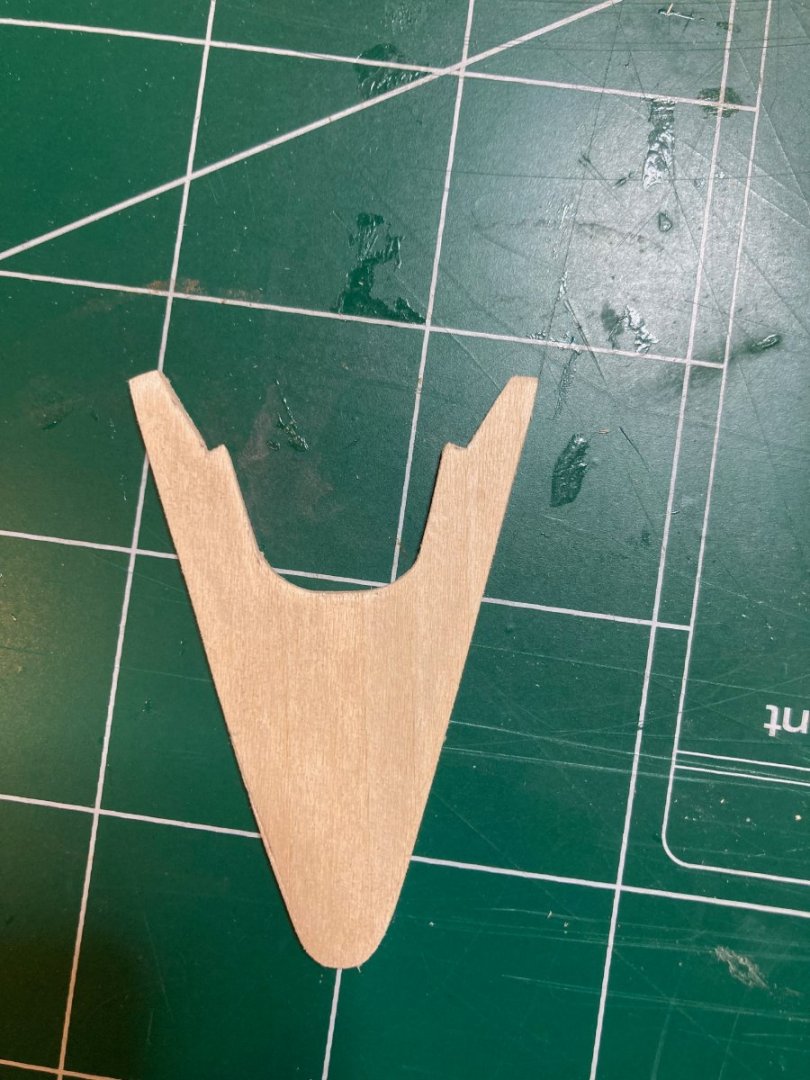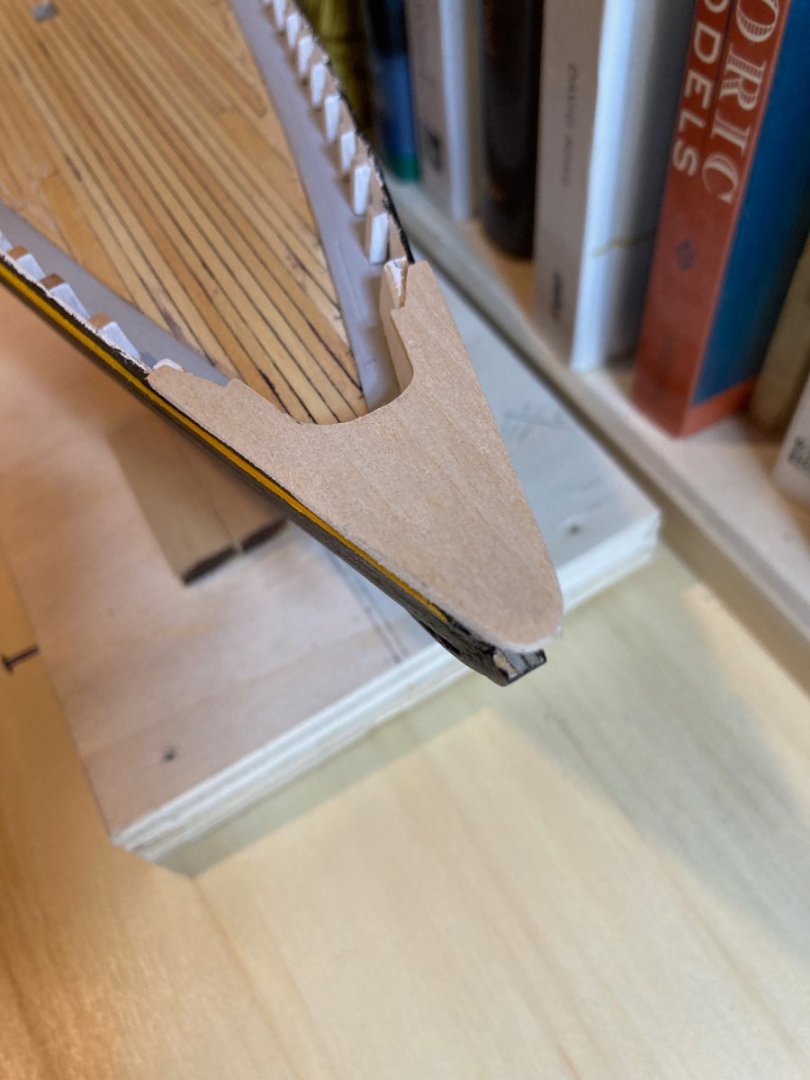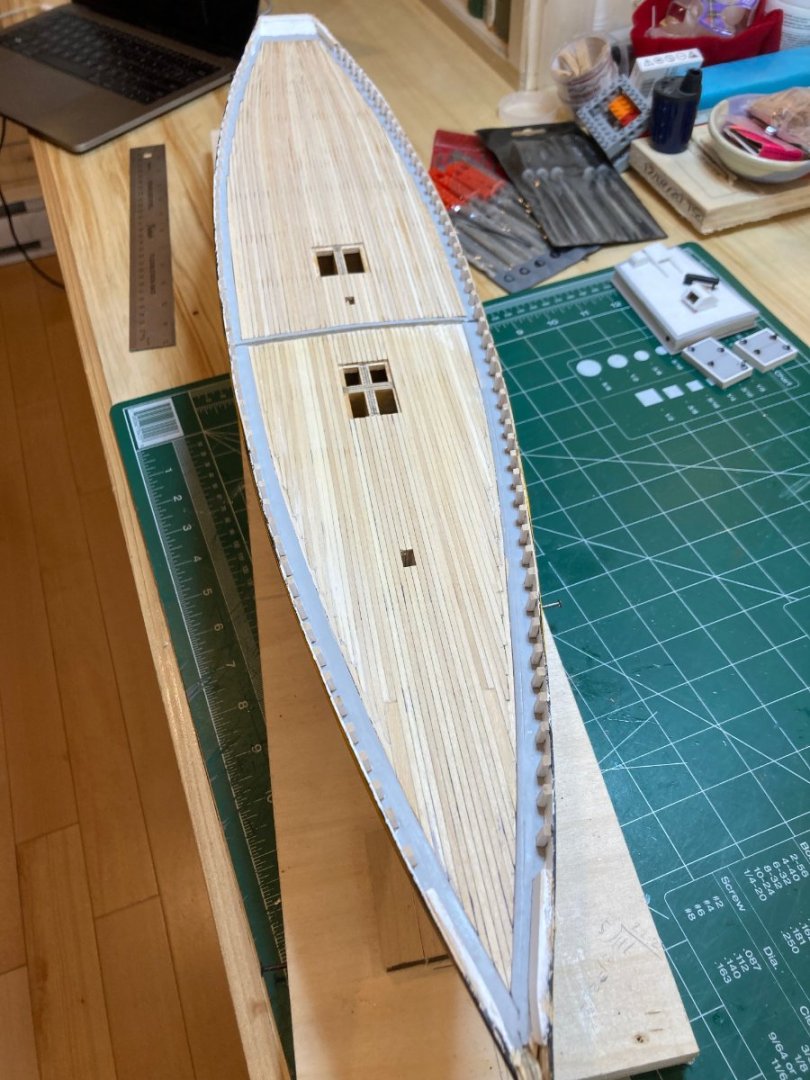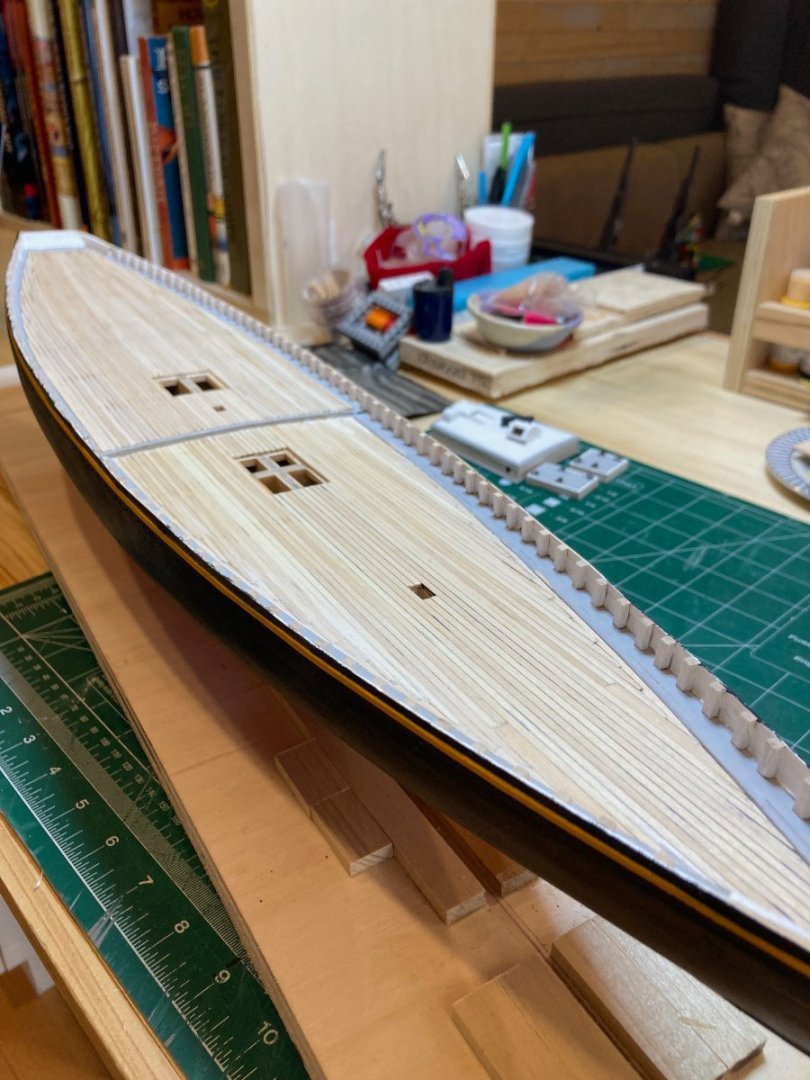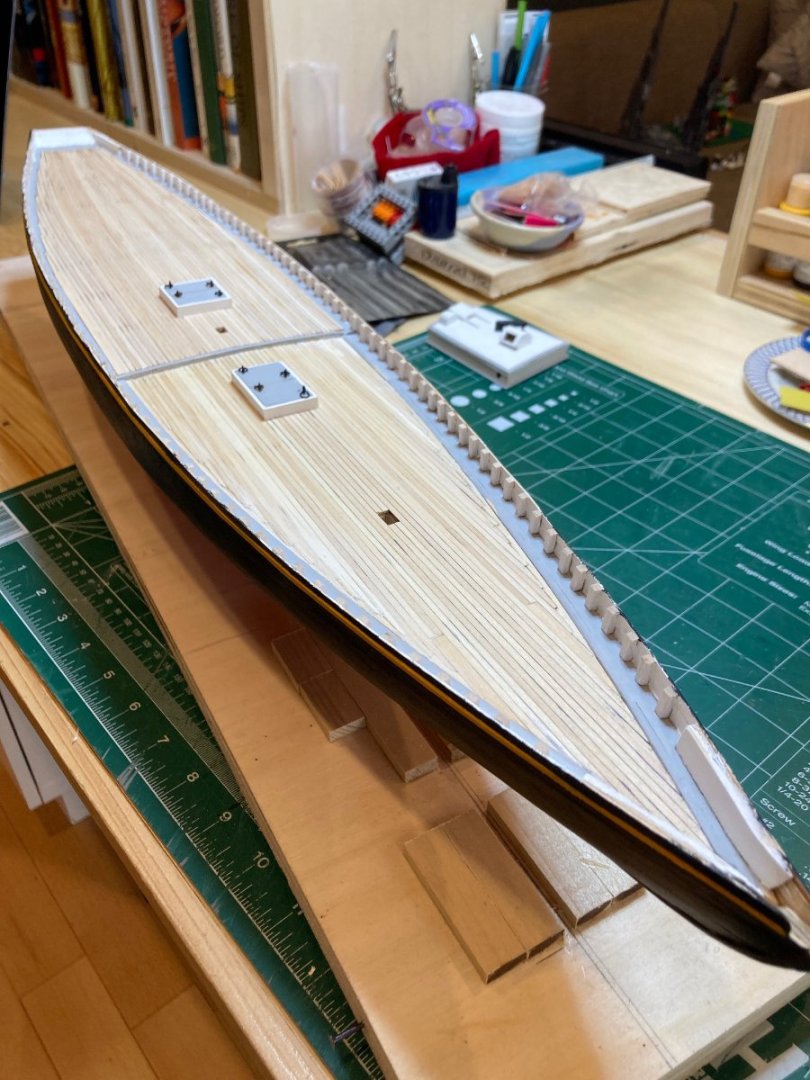-
Posts
1,780 -
Joined
-
Last visited
Content Type
Profiles
Forums
Gallery
Events
Everything posted by hamilton
-
Hi there Another small update as I continue to detail the inboard bulwarks, the rails and the outboard hull. At this point, I've added the mooring chock (needs quite a bit of cleaning up as the photos show), some belaying pins and started on the "monkey rail" - a term that really makes no sense to me even in the context of the usual fancifulness of nautical jargon...but anyways.... The pins you see in the first shots were used to ensure a smooth run of the rails along the centre of the main rail. the aft portion of the monkey rail cap was cut from a sheet of 3/64" basswood - the same sheet from which I'll make the sections of it that comprise the port and starboard caps. I promise that the upward flaring effect you may notice in the final photo is an illusion of the camera! The photos may not be of intrinsic interest - in reality a post like this feels to me more like a notification to the community that I haven't stopped working rather than something soliciting advise or feedback....but here they are and any and all comments are, as usual, welcome. Enjoy and bye for now hamilton
-
Yeah - I've turned away from it for a bit to work on my scratch build of Bluenose, so no updates to report on Bellona - you and I are now at almost exactly the same stage in our builds - but you'll get past me for sure before I get back to mine. I want to complete Bluenose up to the masting and rigging and then I'll move back to Bellona - hopefully sometime in early May. In the meanwhile, I'll follow along with you! hamilton
-
Thanks Alistair & Ron Nowhere near where you guys are at, and after a long hiatus from regular modelling I feel like I need to relearn quite a bit, but this one has been satisfying. Thanks for stopping by! hamilton
-
Always nice to see your work, Alistair - glad to see this log refreshed and looking forward to whatever's coming! hamilton
- 49 replies
-
A very minor update to keep this log active. I've spent the last couple of sessions starting in on detailing the outboard hull, inboard bulwarks and rails. I fabricated and installed the splash rails at the bow and the anchor pads positioned at the aft end of these rails. I also made the hawseports and fashioned the bowsprit shroud chainplates from 1/16 x 1/32" basswood - figured that it would make little difference visually to use wood or brass for this and since the wood is much easier to work with (at least for me) this seemed to be the best route. The photo below shows these before they were painted black. If I can get through some house chores and day job obligations I hope to be able to get to the bench today to work on more of these elements - ringbolts on the inner bulwarks, bobstay chainplates, the aft mooring chock and mooring cleats along the rails, etc. - the little details that really start to bring the model to life. Hope everyone is doing well and enjoying a relaxing Sunday hamilton
-
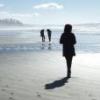
HMS Euryalus 1803 by rlb - 1:48 scale
hamilton replied to rlb's topic in - Build logs for subjects built 1801 - 1850
Looking pretty sweet Ron! hamilton- 122 replies
-
- Euryalus
- Plank-on-frame
-
(and 4 more)
Tagged with:
-
Thanks very much Greg! It's been a slow but fun build! If you measure your fun in years, this is the best hobby! hamilton
-
Hello again The caprails are now complete - a little rough round the edges, but with a bit of detailing and clean-up they should look just fine. The little "bench" that sits beneath the stern caprail was a little tricky to get right and even now it's a little off kilter, but I'm more or less satisfied with it. The process of making and installing these pieces is identical to that described above, so I'll leave you with the photos and sign off! Enjoy! hamilton
-
A little more progress on Bluenose to report. After fashioning the bow and transom main rail pieces, I examined the plans to break the caprail into three sections - the first two will feature the inboard extensions for the belaying pins and the final one aft will complete the rail up to the stern piece. The first sections forward were completed yesterday and today. I started with a 1/16" x 1/2" basswood strip and cut it to the length of the pieces needed. I then laid this strip along the top of the bulwarks and traced the shape of the forward taper of the hull onto it. After cutting this edge, I used a compass to mark the width of the cap rail and then used the same method to trace the pinrail extension. These pieces were then cleaned up using needle files and sandpaper and a slight chamfer added to the outboard edge. As a final preparatory step, I marked out and drilled holes for the belaying pins - these are smaller than they eventually will be, but I wanted to get pilots in before installing the parts. I also further cleaned up and finished the bow and stern main rail pieces - also adding pilot holes for future placement of belaying pins on those parts. The bow piece was then installed permanently and a final trimming of the outboard edge completed. I then refined (as much as my weak eyes and low-level modelling skills allowed) the scarf joints, finished the edges and bottom of the cap rail sections and installed them - adding a final finish to the top. Though the plans recommend finishing the rails black, I have done so in white, as I did on the 1:100 scale BN I built back in 2012. I like the way that the white rails contrast with the black hull and the black monkey rail to be added later. The photos below show the rails with two coats of titanium white, to which I'll add at least one more plus a final protective finish. Enjoy and happy modelling to you all hamilton
-
A few modelling sessions in a single week is a real rarity for me these days, but a welcome one! I managed to eke out some time last night and at lunch today to make the bow and stern sections of the caprail. I made templates of these parts from the plans, and rubber cemented them to a sheet of 1/16" basswood. A bit of work with the scroll saw, sanding blocks and files and I think they came out ok. You'll notice that the main sheet hole in the aft caprail section looks pretty squiffy on the template and on the tracing I took from it on the basswood sheet - this was corrected more or less during the refining process. I hope to be able to spend time this weekend finishing the cap rails and adding some details on the inboard bulwarks, hull and rails - then I think it will be on to the rudder and mounting. Happy modelling all and enjoy the photos hamilton
-
It really is hard to deny the beauty of old Bluenose.....thanks for coming by Grant and Mic! hamilton
-
Well - this was a lot longer coming than I had hoped or anticipated....but finally I'm ready to post some progress on Bluenose. The deck planking is now complete - it took me a while to work my head around the tapered planking on the quarterdeck, but once in the rhythm of things it went more or less smoothly - not the neatest work, but seeing the framework sealed up is satisfaction enough for me. Now the real fun parts can begin!! I'm going to re-do the cabin, which I built over a year ago because it turned out a little bit asymmetrical, but before installing it for good I'll add some external hull and interior bulwark details and the caprails. In the meanwhile, enjoy the photos hamilton
-
Do you mean "work"? "Work" is a 4-letter word on Sundays in my world hamilton
- 978 replies
-
That awful thing!! I remember spending quite some time looking at it and wondering what the heck to do about it....someone pointed out that the frieze on it is actually derived from HMS Victory - built 45 years after Greyhound..... If you check out my build log for HMS Blandford (my Greyhound build) you can see my solution to the transom issue and the related quarter gallery issue...Feel free to crib from that if you're dissatisfied with those parts! It was pointed out to me in my log that my diamond shaped window frames were also out-of-place for the period, but I was so constrained in the materials available to me for this that I had to just not care.... Anyways.....if you can grab some 2mm thick basswood/lime sheeting you can work something up that will function much better than that metal part. You can use the metal part as a template for creating a thin wooden "foundation" for the transom and locating the stern lights and so on. Keep at it!! The rewarding parts will come soon enough!! hamilton
-
Nice looking so far - the wood stock supplied by Corel is, if memory serves, not great. A good soaking in warm water and pre-bending in a jig might help with the splitting. I didn't use the kit-supplied gunport frames but framed out the ports myself with spare wood strips, so I could run longer lengths of planking down the hull, which makes it a bit easier than trying to bend such short runs of planking. But I think a bit of knife work (a scalpel blade will shave off that little flare of wood and some filler ands sandpaper will do the rest) and a bit of filling and sanding will produce a good result. hamilton
-

HMS Euryalus 1803 by rlb - 1:48 scale
hamilton replied to rlb's topic in - Build logs for subjects built 1801 - 1850
This looks amazing Ron - maybe not perfect, but amazing! hamilton- 122 replies
-
- Euryalus
- Plank-on-frame
-
(and 4 more)
Tagged with:
-
Lees was a great help in the rigging, but I found I had to produce an entirely unique set of rigging tables for this build based on his documentation of period practice - not only for accuracy, but just for planning out the build! This led further to having to re-do the numbering and labelling of all kit parts - this was an arduous and time-consuming effort, but it definitely paid off in the levels of sanity I was able to maintain through this build. hamilton
-
Aha!! My Greyhound had this exact same issue at this exact same location. I did not have the tools and Corel does not supply the resources to make new bullkheads here, so I heavily veneered the outboard edges of these bulkheads during the fairing process to create decent hull lines - this is a MUCH cheaper and equally effective solution to the ones you propose above, and to keep your wife happy, I would strongly recommend it - happy wife, happy life! The following is the post from my build log where I identify this same problem: And here is the solution I came up with - using .6mm strips leftover from a previous build. Hope these help - since I built Greyhound as HMS Blandford you can search for the log using that as a search term. I tried to make it quite detailed and it might be helpful as a reference. hamilton
-

HMS Granado by ir3 - CAF - 1:48 - POF
hamilton replied to ir3's topic in - Kit build logs for subjects built from 1501 - 1750
going to follow along as well hamilton -
Hello Srenner This can be a frustrating kit - especially for a beginner, since the instructions are very sketchy and the plans inaccurate. This was my 12th model build and I was happy to go into it with some experience under my belt. Now for some practical advice. The keel can be straightened in construction. Make a building board and run two long strips of wood as keel fasteners - if these strips are straight you can just wedge the keel part in there to keep it straight during construction. When you fit the bulkheads you can add some small support braces between them to make sure they are aligned perpendicular to the keel - once the bulkheads are squared, braced and glued to the keel, the keel will maintain its straightness through the interaction of all these parts. You will undoubtedly encounter a lot of frustrations with this kit - I don't think any modeller on this forum who has built this has not encountered frustrations and challenges, regardless of their level of modelling experience. I would strap yourself in for some serious head scratching in the future - but between Collingwood, Harlequin, myself and others who have built this kit, hopefully we can provide some remote assistance!! She does build into quite a nice looking ship if you can get through the framework portion of the build! Once that's done, it's more or less "smooth sailing" (insert eye roll here....) hamilton
About us
Modelshipworld - Advancing Ship Modeling through Research
SSL Secured
Your security is important for us so this Website is SSL-Secured
NRG Mailing Address
Nautical Research Guild
237 South Lincoln Street
Westmont IL, 60559-1917
Model Ship World ® and the MSW logo are Registered Trademarks, and belong to the Nautical Research Guild (United States Patent and Trademark Office: No. 6,929,264 & No. 6,929,274, registered Dec. 20, 2022)
Helpful Links
About the NRG
If you enjoy building ship models that are historically accurate as well as beautiful, then The Nautical Research Guild (NRG) is just right for you.
The Guild is a non-profit educational organization whose mission is to “Advance Ship Modeling Through Research”. We provide support to our members in their efforts to raise the quality of their model ships.
The Nautical Research Guild has published our world-renowned quarterly magazine, The Nautical Research Journal, since 1955. The pages of the Journal are full of articles by accomplished ship modelers who show you how they create those exquisite details on their models, and by maritime historians who show you the correct details to build. The Journal is available in both print and digital editions. Go to the NRG web site (www.thenrg.org) to download a complimentary digital copy of the Journal. The NRG also publishes plan sets, books and compilations of back issues of the Journal and the former Ships in Scale and Model Ship Builder magazines.


